
Top 3 Best Solar Panels For Sailboats

Last Updated by
Daniel Wade
June 15, 2022
Choosing whether or not to install solar panels on your sailboat is a big decision. They are not exactly cheap, though they can start to pay themselves off pretty quickly.
This article is going to cover not only why you might want to use solar panels but all the benefits they provide. You will also find a helpful guide on which solar panels would be best for you and your budget. Hopefully, by the end, you will feel confident in your decision to install solar panels on your sailboat and even have an idea of which ones you might like.
Table of contents

Are solar panels on sailboats necessary?
Whether or not you should be installing solar panels on your boat is a matter of choice, not out of necessity. Sailboats get their power from the wind, by harnassing it in their sail. So if you plan to be sailing for the afternoon you probably don’t need solar panels.
You could charge a battery pack from the marina and that will probably see you through several trips. The problems only really start to arise if you are planning to be on your sailboat for longer periods, or even permanently. If you plan to live on your sailboat year-round, even if you spend 80% of it in a marina, you would be better off with some solar panels. Even if it is just as a backup source of power.
Are solar panels on boats safe?
Solar panels are generally pretty safe. They have no moving parts and typically have a very strong protective cover over them so you never come in contact with the electrics themself. So, as a source of power, they are generally pretty safe. The only time they may become unsafe is if they are badly damaged.
Solar panels are often covered by glass plating that keeps them safe. It also helps them absorb sunlight and warmth. This is great, except when the glass breaks. If the glass protective cover on your solar panels should crack and splinter you are at risk of serious injury from sharp shards of glass. Not only is the glass itself dangerous at this point, so are the electronic components inside. They have powerful currents running through them, and if you come in contact with them you may be in for a shock.
Furthermore, if these electronics get wet they can become deadly. Electricity and water do not mix well at all. Being as you are on a sailboat, at sea, the chances of them getting wet is very high. Luckily, the chances of them breaking in the first place are slim to none. The only real way they would break, besides vandalism, is by debris hitting them during a bad storm. There is not often debris at sea, so this shouldn’t be too much of a problem.
What are the benefits of having solar panels on a sailboat?
There are so many great benefits of having solar panels on a sailboat. They can be a lifesaver if you find yourself at sea for a long time. There benefits range from trivial comforts to being the difference between life and death. Here are some of the benefits you might not have considered about having solar panels installed on your sailboat.
Money-saving
Solar panels are not cheap, it is far cheaper to just run a generator or charge your batteries from the marina the whole time. At least, it is in the short term. Over time, it can start to become very expensive. With solar panels, you are looking at a big initial cost (the solar panels themself) and then it’s smooth sailing. You don’t need to pay for power again. Solar panels last for about 40 years before they start to become too inefficient at producing power. The cost of a few solar panels upfront compared to 40 years of marina fees and gasoline for a generator is the financially savvy move.
Emergency power
If you find yourself at sea, the wind dies down (or becomes too strong), and you find yourself stuck bobbing around waiting for more favorable conditions you may run into trouble. Depending on how long you are out there, you may find yourself with dead electronics. Be it a satellite phone, radio, or secondary engine (depending on the boat). Having a set of solar panels and a power bank can be a genuine lifesaver in these situations.
Comfort amenities
Whether you are day sailing or making a week-long voyage, having access to the comforts in life can make the whole journey so much more enjoyable. The amenities may not be available to you without having a constant source of power at sea. Having access to a kettle, tv, videogame system, radio or microwave oven may be the only thing keeping you going at rougher times. As exciting as sailing can be, when you aren’t sailing and are just bobbing around it can be quite dull. The sea is beautiful, but there is only so much time you can spend looking at the water before you miss the comforts of land. With solar panels, you can bring those comforts with you.
Eco-friendly
There are only two alternatives to solar panels. A gasoline generator, and taking power from the grid. Neither of these is good for the environment. Luckily, solar panels are a great third option. Solar panels are completely eco-friendly and are great for the environment. This is not just great for the earth, and your conscience, but for the journey itself. If you are running a gasoline generator at sea you are going to be listening to it thrumming away and smell the burning gasoline. Wouldnt you prefer silence and nothing but the smell of the sea breeze?
How much do solar panels cost?
How much solar panels cost is almost entirely tied into both their voltage/wattage and whether or not they are portable panels. Portable solar panels are great for people who don’t spend a lot of time on their boat or are happy enough living off the marina’s power grid. Permanent solar panels, the kind that may need to professionally installed, can end up costing far more. They are also likely to be far superior and you can pretty much forget about them once they are installed.
Portable solar panels will cost just a few hundred dollars each. You will need a few to be sustainable, but that’s not going to be much of a problem. These portable solar panels can just be rolled out on the deck of your boat, weighed down, and then hooked up to a battery pack. The battery itself here is going to be the most expensive part of the whole set up. A decent-sized battery could set you back a $1000. But, when charged fully it will last days. Even with constant use.
Permanently installed solar panels can cost one or two thousand dollars in some cases. The advantage here though is once they are installed that’s it, you can forget about them. You don’t have to put them up, take them down, and find somewhere to stow them every time they need using. They too will need to be hooked up to a battery, the battery is still only going to cost you $1000. If you are installing permanent solar panels because you plan to be making long voyages, it is ideal to have two or perhaps even three large batteries hooked up to your boat. One to run off, one or two for emergencies.
How do I maintain my solar panels?
Solar panels, unlike gasoline generators, are generally pretty easy to maintain. They have no moving parts and are thus pretty self-sufficient. They don’t need taking apart and they last as long as 40 years. That being said, if they do break they need repairing as soon as possible. The exposed electrics can be deadly when water is thrown into the mix. Which, on a boat, is almost always. The glass cover will need replacing and the electronics inside may need repairing, though not always. Don’t ever attempt to do this yourself unless you are experienced at making these repairs. The cost of hiring someone to do it for you is preferable to being dead. Solar panels have very powerful electric currents, that when in contact with water and yourself can be fatal. As mentioned above, these panels rarely break so you will likely not ever run into this problem. If you do, hire a contractor.
Do my solar panels need cleaning?
Solar panels work by converting the light and heat of the sun into useable power. The process itself is rather complicated but the results are simple to understand. That being said, there are some reasons that your solar panels will stop working as effectively. They all revolve around a lack of sunlight. It could be because it is night time. It could be because it is very cloudy. Or, it could be because they are dirty. If solar panels become too dusty, dirty, and become too covered in grime they stop operating at maximum efficiency. This is not as much of a problem at sea, the sea spray stops dust settling. The biggest thing you will need to clean off your solar panels is salt build-up and slime. This is easy enough to do with some warm soapy water. Freshwater, not seawater. You want to be removing as much salt as possible. Salt is corrosive to electronics, so removing it is important. Never clean your solar panels using pressure washers as they can crack the glass.
Which are the best solar panels for sailing?
There are so many options on the market at various price points. Here are three very different options that will all make good choices, depending on your needs. It is important to consider not just price but power output. Spending a lot of money on solar panels now might not feel ideal, but it is the most cost-effective decision.
1. Renogy Starter Kit
This starter kit is going to be perfect for installing on almost any sized boat. There are four solar panels, each can be fitted permanently to the boat. They can be mounted (and unmounted) easily, for your convenience. They do require a flat surface, but they are small enough that that likely won’t be too much of a problem. This starter kit is very middle of the pack price-wise but should provide enough power for a small to medium-sized vessel easily. It is also possible to buy extra panels individually should you need them.
Wattage: 400/4 (100 per panel)
2. Nature Power Rigid
The nature power rigid is a large, powerful, single solar panel. If you are looking for the right panels to power your entire boat comfortably, these are the ones for you. They are very large so they will need a large flat surface area. alternatively, they can be hung vertically from rails. This is an inefficient way of using them, so you would need to buy more this way. Nature power makes various solar panels so you could find some smaller ones of the same brand to supplement it. This one is not so easy to install, you might need to hire someone to install it for you.
Wattage: 165
3. Nature Power Monocrystalline
Nature power makes a portable solar panel that fits inside a special briefcase. It is perfect for stowing away easily and only taking it out when it is needed. It is decently powerful considering its portable, but there is the inconvenience factor of having to set it up each time. If you planned to buy the nature power rigid, buying one of these portable panels might be ideal for supplementing your power supply when it is especially sunny. Though, it may be cheaper for you to just fit more of the Nature Power Rigids.
Wattage: 120
Hopefully, you now have a good idea about whether solar panels would be right for you and your sailboat. Sailing is great, but the lack of power at sea can be dreadfully boring. Luckily, there are so many great options available on the market. Not just the ones mentioned above. Buying a solar panel is an investment, the initial cost is minor compared to the steady return from all the savings you will make.
Related Articles
I've personally had thousands of questions about sailing and sailboats over the years. As I learn and experience sailing, and the community, I share the answers that work and make sense to me, here on Life of Sailing.
by this author
Sailboat Upgrades
Most Recent

What Does "Sailing By The Lee" Mean?
October 3, 2023

The Best Sailing Schools And Programs: Reviews & Ratings
September 26, 2023
Important Legal Info
Lifeofsailing.com is a participant in the Amazon Services LLC Associates Program, an affiliate advertising program designed to provide a means for sites to earn advertising fees by advertising and linking to Amazon. This site also participates in other affiliate programs and is compensated for referring traffic and business to these companies.
Similar Posts

How To Choose The Right Sailing Instructor
August 16, 2023

Cost To Sail Around The World
May 16, 2023

Small Sailboat Sizes: A Complete Guide
October 30, 2022
Popular Posts

Best Liveaboard Catamaran Sailboats
December 28, 2023

Can a Novice Sail Around the World?
Elizabeth O'Malley

4 Best Electric Outboard Motors

How Long Did It Take The Vikings To Sail To England?

10 Best Sailboat Brands (And Why)
December 20, 2023

7 Best Places To Liveaboard A Sailboat
Get the best sailing content.
Top Rated Posts
Lifeofsailing.com is a participant in the Amazon Services LLC Associates Program, an affiliate advertising program designed to provide a means for sites to earn advertising fees by advertising and linking to Amazon. This site also participates in other affiliate programs and is compensated for referring traffic and business to these companies. (866) 342-SAIL
© 2024 Life of Sailing Email: [email protected] Address: 11816 Inwood Rd #3024 Dallas, TX 75244 Disclaimer Privacy Policy

Service Locator
- Angler Endorsement
- Boat Towing Coverage
- Mechanical Breakdown
- Insurance Requirements in Mexico
- Agreed Hull Value
- Actual Cash Value
- Liability Only
- Insurance Payment Options
- Claims Information
- Towing Service Agreement
- Membership Plans
- Boat Show Tickets
- BoatUS Boats For Sale
- Membership Payment Options
- Consumer Affairs
- Boat Documentation Requirements
- Installation Instructions
- Shipping & Handling Information
- Contact Boat Lettering
- End User Agreement
- Frequently Asked Questions
- Vessel Documentation
- BoatUS Foundation
- Government Affairs
- Powercruisers
- Buying & Selling Advice
- Maintenance
- Tow Vehicles
- Make & Create
- Makeovers & Refitting
- Accessories
- Electronics
- Skills, Tips, Tools
- Spring Preparation
- Winterization
- Boaters’ Rights
- Environment & Clean Water
- Boat Safety
- Navigational Hazards
- Personal Safety
- Batteries & Onboard Power
- Motors, Engines, Propulsion
- Best Day on the Water
- Books & Movies
- Communication & Etiquette
- Contests & Sweepstakes
- Colleges & Tech Schools
- Food, Drink, Entertainment
- New To Boating
- Travel & Destinations
- Watersports
- Anchors & Anchoring
- Boat Handling
- ← Technology
What You Need To Know About Boat Solar Panels
Advertisement
Sunshine and boats are a natural together, so why not use all that free energy? Here’s the lowdown on solar panel selection and installation
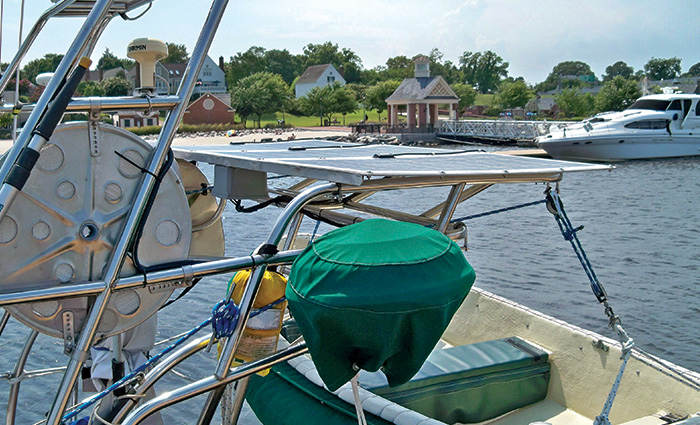
I first embraced the idea of solar power while up a pole (literally) in the Atlantic Intracoastal Waterway replacing dead batteries. It was the early 1980s, and I was maintaining buoys, beacons, and other such Aids To Navigation (ATON) for the U.S. Coast Guard, replacing massive, nonrechargeable batteries with rechargeable solar-powered ones. The higher-ups said the solar rechargeables would last six years – twice as long as the one-shot batteries. As the deck-ape in charge of lugging all those batteries up and down the ladders, my back and I immediately appreciated the whole “free power from the sun” thing, a concept I continue to embrace.
The strategy behind s olar energy onboard is simple: A solar panel converts sunlight into electricity, after which wiring conducts it to your batteries for storage until needed. Solar panels are used to keep batteries or banks charged rather than to power equipment directly. This arrangement allows the panels to store generated power whenever produced, while providing a steady source of power to a piece of equipment even when the panel is producing no power.
While they do require an initial outlay, solar panels can easily pay for themselves in money saved and independence gained over their service life. They’re noiseless, have no moving parts, and they provide free electricity for years with minimal maintenance. Solar panels also have the benefit of being modular, letting you start small and add more as your power requirements increase.
The benefits of solar
Almost any boat can benefit from solar power. Whether at a slip, mooring, or on a trailer, boats can keep their batteries topped off without the need for external power. You can also use solar power to supplement or even replace other onboard charging sources, reducing or eliminating the need to run engines or generators to keep batteries topped off (a wasteful practice that burns fuel while wearing down the costliest pieces of equipment onboard).
While underway, it’s a plus to be able to recharge a dead battery in an emergency – say, to operate a VHF radio or navigation gear. While dockside, solar panels keep batteries charged and vital systems (such as bilge pumps) up and running without the need for shore power.
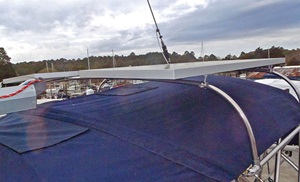
Just about any boat can benefit from solar power, whether it’s to keep batteries topped off or supplement other onboard charging sources.
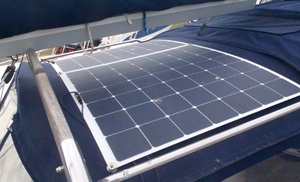
Mount solar panels where they are exposed to maximum sunlight but do not interfere with operation of the vessel.
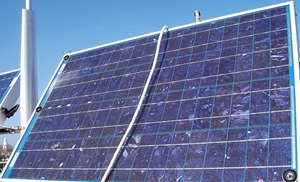
Bottom: Something as simple as the shadow of a line or shroud can reduce or halt output.
Types of panels
Solar panels contain photovoltaic cells – small silicon semiconductor devices that convert sunlight into electricity. Each cell generates between 0.45 and 0.5 volts, depending on exposure to direct sunlight. Cell size determines amperage, with a 3-inch cell producing roughly 2 amps, a 4-inch cell a little over 3 amps, and a 5-inch cell around 5 amps.
Construction-wise, the three main types of solar panels are monocrystalline, polycrystalline, and amorphous (or thin-film) technology.
Monocrystalline panels have been around the longest and remain the most popular. The panels are constructed of thin slices of crystal silicon (each cell is cut from a single crystal) housed in a rigid, aluminum frame and covered with tempered shatterproof glass. The panels have a uniform black, blue, or gray appearance and are generally quite rugged, although they can be cracked or broken if subjected to extreme abuse.
Monocrystalline panels have the longest service life of the three types. With a conversion efficiency of around 17%, they’re also the most efficient and have the highest electrical output per area, but they are also the most expensive.
Polycrystalline cells are sliced from a cast silicon block and have a shattered glass appearance. Built in much the same way as monocrystalline panels, they’re rectangular, giving the panel itself a tiled look. Their life span is similar to monocrystalline panels, and while their conversion efficiency is lower (by 14%), they’re also a bit less expensive.
Amorphous panels are made by placing a thin film of active silicon on a solid or flexible backing (such as stainless or aluminum sheeting) depending on whether the panel is to be rigid-framed and glass-fronted or flexible. Flexible amorphous panels, in which cells are sandwiched between rubber and polymer covers, are light and tough enough that you can walk on them and, in some cases, even roll them up for storage.
This type of solar panel is also better if shade is an issue. With crystalline panels, even the thin shadow of a rope or shroud across one cell can reduce or halt output of an entire module. Amorphous panels have “bypass” diodes that essentially turn off shaded cells and provide a current path around them. Some monocrystalline panels also have bypass diodes, but this feature comes at an increase in cost.
Amorphous panels are the least expensive of the three types, but their efficiency is also lower – around 8%, or roughly half that of a monocrystalline type. This lower output is somewhat mitigated in newer panels, however, which use three-layer construction. Each layer absorbs different colors of the solar spectrum, so the panel will deliver more power longer each day and during lower light conditions than the other two types.
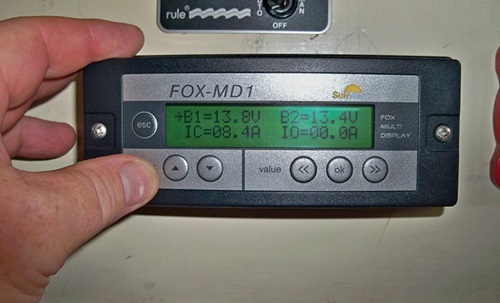
The charge controller should be mounted below decks and as close to the battery as possible.
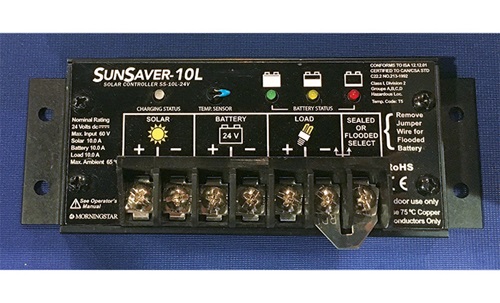
Follow manufacturer instructions for wire connections.
Planning the system
While factors such as cost, mounting options, and output are important, a successful installation depends on knowing what you want the system to accomplish. Is the goal to float-charge a single battery or supplement an overall vessel energy plan? Answering these questions up front will help determine the type, size, and number of panels required.
To understand the process better, let’s walk through the basic steps to determine power requirements and installation considerations for a single solar panel installation. While the example itself is simple, the steps are the same used to plan more complicated installations.
For our example, the goal is to install a solar panel to provide charging for a single 12-volt, 100-amp-hour wet-cell battery used to power an automatic anchor light on a moored vessel.
The first step is compiling a daily power consumption estimate to determine how much solar power is needed.
The daily self-discharge rate for a wet-cell battery is roughly 1%, meaning our 100-amp-hour battery requires one amp every 24 hours just to maintain the status quo. The anchor light draws 50 milliamps per hour of operation, and we’ll assume it operates 10 hours each night. Multiplying current draw (50 milliamps) by hours of daily operation (10) generates a daily energy expense of 500 milliamps or .5 amps.
This means our solar panel must meet a minimum daily energy tab of 1.5 amps – one amp of battery self-discharge rate plus .5 amps of power draw for the anchor light.
Next up is figuring out panel size and the best mounting location. For our example, let’s assume the panel will be a horizontal, fixed-mount installation. A 10-watt horizontally mounted panel should generate between 3- and 5-amp hours per day.
We’ll need at least 13 volts to fully charge our 12-volt battery. As most solar cells generate at least 0.45 volts, you’ll want a panel with a minimum of 33 cells, which should provide around 14.85 volts.
Keep in mind that’s the minimum needed, which may not be enough once you factor in a few cloudy days. Most panels are designed to generate between 15 and 20 volts to overcome problems like cloudy days or inherent electrical resistance within the panel or installation components. While this higher voltage lets you make up for less electrically productive days, it also means you’ll want to install a solar charge controller (voltage regulator) to avoid battery damage due to overcharging.
Attempts to plan a system that tries to use the output of the panel and capacity of the battery to prevent overcharging (and avoid the installation of a charge controller) is false economy and should not be done. The system will never meet its full output potential and, worst case, can damage the battery due to overcharging.
A word on ‘charge controller confliction’
If your vessel has multiple charging sources, such as solar panels and a wind turbine, a crucial but often overlooked consideration is “charge controller confliction.” In short, this is an issue where the charge controller for your solar panel and the charge controller for your wind turbine are internally adjusted to the same maximum charge voltage set point. This means they are constantly fighting each other to be the dominant power source, which results in diminished overall charging output and performance. An in-depth article on this issue can be found at missioncriticalenergy.com (in the website footer, click “Superwind Turbine Manuals & Technical Bulletins.” Under the header “Charge Controllers,” select the document “Resolving Charge Controller Confliction”).
While this article addresses charge controller confliction at remote, off-grid sites, the information provided is also applicable to vessel installations. — F.L.
Location and mounting
Solar panels should be mounted in a location where they are exposed to the maximum amount of sunlight but do not interfere with operation of the vessel or the movement of passengers and crew. Solar panels will typically be either fixed or mounted on some type of movable bracket that allows you to actively point the panel toward the sun for maximum output. Both methods have their pros and cons. Fixed panels (which are normally mounted horizontally) don’t produce as much power as a panel that can be adjusted to face the sun. The downside is that adjustable panels must be aimed throughout the day to maximize their output.
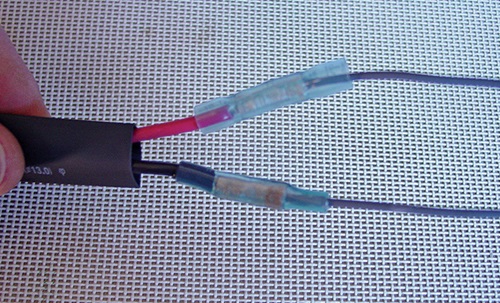
Use good quality, marine-grade heat shrink connectors (top) and liquid electrical tape (right) to create airtight, waterproof seals and reduce corrosion.
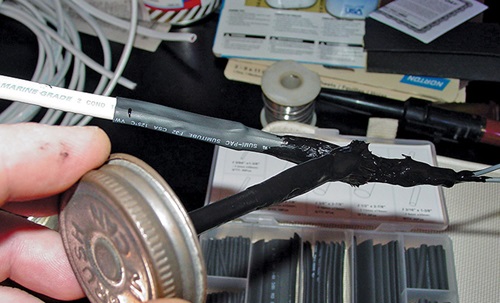
Installation
After choosing and mounting your panel, it’s time to connect it. The first thing you need to determine is the size (gauge) of the wiring to be used. Multiply your panel’s rated amp output by 1.25 (which adds a 25% safety factor). Then measure the length of the entire wiring run, panel to battery, and multiply by 2. Once you have these two numbers, refer to the American Boat and Yacht Council’s (ABYC) 3% voltage-drop table for wire size. Ancor Products offers a handy wire calculator on its website ( ancorproducts.com/resources ).
Always use good quality marine grade connectors and tinned, multi-stranded copper wire with vinyl sheathing. The wire will run from the solar panel to the charge controller first, then to the battery. Try to keep the wire run as short as possible, and if it transits an external deck or cabin house (it likely will), be sure to use an appropriate weatherproof deck fitting.
The charge controller should be mounted below decks and as close to the battery as possible. You’ll always want to follow the manufacturer’s instructions for connections, but in a typical installation you’ll connect the solar panel’s positive (red wire) lead to the charge controller’s positive input wire or terminal and the negative (black wire) lead to the charge controller’s negative input wire or terminal.
Next, connect the charge controller’s negative output to the battery negative terminal and the controller’s positive output to the battery’s positive terminal via an appropriately sized in-line fuse (or circuit breaker). ABYC recommends these be installed within 7 inches of connection to the battery or other point in the DC system. To reiterate, the installation of the charge controller can vary among models, so follow the manufacturer’s installation instructions.
Finally, ensure all connections are waterproof and secure any loose wire runs with wire ties and cable clamps for a neat installation. Then get ready to lean back and soak up some free sun.
Related Articles
The truth about ceramic coatings for boats.
Our editor investigates the marketing claims of consumer-grade ceramic coatings.
Fine-Tune Your Side Scan Fishfinder
Take your side-scanning fishfinder off auto mode, and you’ll be spotting your prey from afar in no time
DIY Boat Foam Decking
Closed-cell foam flooring helps make boating more comfortable. Here’s how to install it on your vessel
Click to explore related articles
Frank Lanier
Contributing Editor, BoatUS Magazine
Capt. Frank Lanier is a SAMS Accredited Marine Surveyor with more than 40 years of experience in the marine and diving industries. He’s also an author, public speaker, and multiple award-winning journalist whose articles on boat maintenance, repair, and seamanship appear regularly in numerous marine publications worldwide. He can be reached via his YouTube channel “Everything Boats with Capt. Frank Lanier” and website captfklanier.com.
BoatUS Magazine Is A Benefit Of BoatUS Membership
Membership Benefits Include:
Subscription to the print version of BoatUS Magazine
4% back on purchases from West Marine stores or online at WestMarine.com
Discounts on fuel, transient slips, repairs and more at over 1,200 businesses
Deals on cruises, charters, car rentals, hotel stays and more…
All for only $25/year!
We use cookies to enhance your visit to our website and to improve your experience. By continuing to use our website, you’re agreeing to our cookie policy.
- Sign in / Register
- Comparison list
- Solar on the go
Picking the best solar panels for a sailboat: Buyer’s guide
- 18 Aug 2022

You might have already heard of brave sailors that conquer the oceans with nothing but wits and solar panels. For instance, this year 83-year-old Kenichi Horie became the oldest person to sail solo from the US to Japan on a solar-powered boat. These stories are inspiring, but picking panels for your boat yourself can be a small challenge in itself. That’s why we wrote a short article about the best solar panels for sailboats and how to recognize them.
Start from type of solar panels
When it comes to solar panels for sailboats, their weight and size matters more than with PV modules for residential systems. Efficiency is important but power — not that much, because the energy needs of a boat are relatively low. The first thing you’ll have to decide about your panels is their type.
Generally, you’ll choose between thin-film panels and monocrystalline modules. While polycrystalline panels are still around and they are indeed cheaper than mono panels, they are much less efficient, which means they’ll need more space and add more weight to your boat.

Thin-film panels are light and cheap
Thin-film or flexible solar panels bend well and they are very easy to install which makes them a great choice for boats with difficult configurations. Some sailors say that flexible panels are the best choice for fast boats because they don’t impact the aerodynamics of a vessel as much as rigid panels do.
The downside of flexible panels is their low wattage. If there are many appliances on board, you’ll need several panels and you’ll need to find the right place for each of them. They also age faster than rigid panels — a thin-film panel generally lasts for 10-15 years.
Monocrystalline panels are powerful and reliable
Rigid solar modules, monocrystalline and polycrystalline, are heavier and bulkier than thin-film panels. You can fix flexible panels with adhesives, but rigid panels require drilling. They are also more expensive than flexible panels.
On the other hand, monocrystalline panels are the most efficient type of panels which means that they provide more power for less space. Even one powerful mono panel can be enough for everything that you’ve got on board. They are also much more reliable and will survive any storm that is coming your way. A monocrystalline panel lasts for at least 25 years.
Panels for boat should be efficient and sturdy
The best solar panels for sailboats don’t have to be powerful, but they better be efficient — find the number in the datasheet. For rigid panels anything over 18-19% is fine. Panels also should be sturdy enough to withstand seastorms. You generally also want good shading tolerance since panels often get shaded by masts and sails. Finally, good performance in low-light conditions is appreciated.
Picking bifacial panels, 72/144-cell panels or larger, anything too powerful generally doesn't make a lot of sense. Performance at high temperatures matters less than it does with home systems. Warranties also play a lesser role. You won’t be able to make use of them because they generally have effect only for residential installations.
The markets of thin-film and rigid panels are different. Generally, a manufacturer of flexible panels doesn’t offer mono- or poly-panels. Canadian Solar, Q CELLS and Jinko Solar are good choices when it comes to monocrystalline modules for boats. Renogy , WindyNation and PowerFilm make fine thin-film panels.
Do the math before purchase
The amount of power for your boat depends on the number of appliances on your board. There are two main ways to determine the size of installation that you need. You can take a test trip and see how much of your battery’s charge you’ve spent in one day. You can also do the calculations manually: write down all the appliances on the board with their power rating and number of hours in use per day. You can read about it in detail in our article " How much solar power to sail the seas? " It doesn’t make sense to oversize a marine PV system, because all the excess power will just go to waste.
Keep in mind that adding photovoltaics doesn’t make your vessel a solar boat, unless you have a solar-powered motor. You can switch your boat to solar energy fully, especially if it’s small, but you’ll have to calculate your energy needs accordingly.

Once you’ve purchased your panels, you’ll have to install them properly. You can order professional service or do it yourself. The most popular places for solar panels on a boat are a stern rail, masts, deck and canvas. Thin-film panels can even go on the sails. Ideally, you want a place where panels wouldn’t be shaded by masts on any other parts of a boat.
List of solar panels for a sailboat
We’ve asked our engineer to pick the panels that would complement a small boat well. These are his choices:
ZNShine Solar ZXM6-NH120-370/M

Solar panels from ZNShine Solar are inexpensive and fit all kinds of applications, including boat systems. ZXM6-NH120-370/M provides 370 Watts of power with a 19.88% efficiency. It performs well in low-light conditions. Graphene coating increases power generation and allows self-cleaning. The only downside is a lower wind tolerance, compared to other models: it is rated to withstand 2400 Pa pressure which is comparable to 140 mph wind.
Mission Solar MSE345SX5T

MSE 345 is a simple solar panel for all kinds of applications, including boat installations. Mission Solar panels are manufactured in Texas. The module provides 345 Watts of power with 18.7% efficiency. It is certified for high snow (5400 Pa) and wind loads (4000 Pa). The model is resistant to salt mist corrosion.
Suntech STP 365 S

Suntech is a Chinese company that offers quality budget-friendly solar panels. The STP365S model stands out in line because of its great performance in weak light, such as cloudy weather and mornings. It is designed to withstand harsh weather conditions, and the module is certified to tolerate wind of over 170 mph. Half-cut design makes cells sturdier and improves shading tolerance. Overall, this panel earns a place among the best boat solar panels.

Andrey had been a news editor and freelance writer for a number of medias before joining A1SolarStore team. Climate change and its impact on people's lives has always been among his interests and it partially explains his degree in Philosophy and Ethics.
Solar monitoring systems: All under control
Inergy solar generators review: Taking charge
AC vs DC-coupled solar battery systems: Pros and cons
How to clean RV solar panels
Solar panel size range: From tiny to large
Learn about the latest arrivals and discounts first!
By clicking "Subscribe", I agree by electronic signature to: (1) receive marketing and other texts and messages from A1SolarStore, directly or from third parties acting on its behalf, at the email address I entered above; (2) the Terms and Conditions ; and (3) the Privacy Policy .
Save 40% off! Join our newsletter and get 40% off right away!
Sailboat Life
Sailboat Cruising and Lifestyle Magazine.

Sailboat Solar Systems and How-To

Solar on a sailboat goes together like hands and gloves, but sailboat solar systems can be installed in a variety of ways. The solar components themselves create an infinite combination of possibilities for off-grid sailing. Victron Energy chargers, Renogy Panels, Sunpower Yachts, BlueSea Systems, and many more brands have entered the marketplace, and that’s not including the lithium battery companies.
To simplify things, we’ve compiled three sailboat solar systems videos to give you an overview of what’s possible. And to help you decide on your own simple solar panel setup for sailing.
How-To Install Solar Panels on Your Sailboat
This system from Zingaro shows flexible panels summing 300w of power on a 38′ catamaran.
300W Solar System:
- Three 100w solar flexible panels
- 1 MPPT Solar charger controller
View on Amazon >>
100W HQST Flexible Solar Panels $100-$200
20amp Solar Charge Controller by Victron Energy $150-$200

Simple Sunpower Solar System
This simple solar system from The Fosters shows a quick and easy setup with limited space on top of a bimini.
Sunpower Solar Panels are considered by most in the industry as the gold standard. They use the highest-efficiency solar cells and have top-notch build quality. In this simple installation, three 50w panels are just enough to get you started. Plus, it’s the most affordable installation!
150w Starter Solar System
- Three 50w Flexible Solar Panels
- A Single 15amp solar charge controller
50W Sunpower Solar Panels $150-$200
75v/15amp Solar Charge Controller by Victron Energy $100-$124

Off-Grid on a DIY Solar Powered Sailboat
Here’s a special installation that turned a derelict sailboat into an off-grid sailing machine!
Simon has transformed this derelict sailboat into an epic off-grid solar-powered and fossil-fuel-free cruising catamaran. He’s been living aboard and renovating the boat for the past 3.5 years We’re excited to show you the transformation as well as how he plans to propel the boat without the use of diesel or fossil fuels!
5280w Solar System for Electric Powered Catamaran
- 16 Rigid solar panels (330w each)
- 20kwh of Lithium Batteries
240W Rigid Solar Panels $250-$300
200AH Lithium 4d Battery $1200-$1200

Share this post!
Throw in your two cents, start a discussion cancel reply, related articles.

The Voyage of the Sea Star – 35ft Sloop to Bermuda

Living Aboard a 30-36ft Sailboat: A Guide for the Curious and Adventurous

Summer Sailboat Video, Bikinis, Sails, and Fun

Saved Up For This Dream
Yachting Monthly
- Digital edition

Best Solar panels for off-grid power and keeping batteries charged
- Phil Sampson
- November 28, 2022
We take a look at 6 of the best solar panels for boats, from folding units to cutting-edge flexible panels

Free power forever? If only it was that simple! Photo: Graham Snook
For many in the boating community, solar panels represent something of a holy grail. They are, after all, the gift that keeps on giving, aren’t they? Free power forever, (or many years anyway), coupled with zero running costs – what could possibly be better than that?
All you have to do to make this dream come true is banish the memory of the purchase price from your mind – something boaters are notoriously adept at doing – and wait for the sun to shine. If only it were that simple…
The fact of the matter is that there are costs associated with solar panels beyond the price of the panels themselves. While some types of panels can be simply laid on the deck, in many cases some form of mount will be required.
Then there’s the wiring to hook them up to your battery, plus any fitment and/or cosmetic work needed to hide the cabling from view. If your panels are to be left connected permanently, you’ll require a regulator too.
This will prevent both overcharging and a reverse flow of power out of the battery after dark. If you do not fit a regulator, a blocking diode can be used to halt the reverse flow instead.
But once all of the above have been overcome – and providing you’ve done your homework to ensure your panels will generate sufficient power to cover your needs – then, yes, it’s a power free for all!
There are many other benefits to boat solar panels too: First and foremost, they work all on their own – solar panels are automatic, so you can just let them get on with the job.
Apart from the occasional wipe over and a wiring check, they’re largely maintenance-free too. Unlike wind generators, (especially like the one with wonky bearings on that boat moored next to you), they don’t make any noise.
And finally, your batteries will be pleased, because keeping them from going flat can extend their life.
Here’s our choice of the best boat solar panels.
6 of the best boat solar panels available right now

Giosolar 1,000W flexible solar panel
Best flexible boat solar panel
Delivering a mighty kilowatt of power, (not far off the amount used by a one bedroom house), this Giostar package comprises ten separate 100W panels, each of which is 1,050 x 540 x 2.5mm in size.
Capable of charging either 12 or 24V batteries, a kit of this magnitude is one for the most serious of solar enthusiasts – Eco Experts reckons 660-990W is sufficient for a liveaboard.
Giostar panels are abrasion resistant, anti-rust and dust proof and their junction boxes are sealed and waterproof. The panels are also light, thin and flexible, and can withstand being bent up to 30 degrees.
Reasons to buy: Incredible amount of power, panels are abrasion resistant as well as anti rust + dust proof
Reasons to avoid: Premium price
Price: £1,464.45
Buy it now on Amazon (UK)
Note: We may earn a commission when you buy through links on our site, at no extra cost to you. This doesn’t affect our editorial independence.
Ecoflow 160w portable solar panel.

Mobisolar 100W foldable solar panel
Best foldable boat solar panel
Mobisolar’s foldable panels are light (4.5kg) and measure 121 x 56.5 x 3 cm when unfolded, with the longest dimension reducing to 60 cm when folded, making them easy to transport.
The panels use advanced technology to provide superior performance, with each panel subjected to a thorough testing routine before and after assembly.
So confident is Mobisolar in its products that the company stands behind its panels with a two-year defect warranty and a five years’ electrical performance warranty.
For maximum flexibility in operation, three USB power outputs are fitted per panel, one delivering 100W, the second 60W and the third 10W.
Reasons to buy: Foldable, lightweight and long warranty
Reasons to avoid: Not resistant to the elements, doesn’t feature mounting holes
Price: £145.00
Buy it now on eBay

Eco-worthy 100W solar panel kit
With 100W panels being ideal for keeping batteries topped up, our second offering in this power class is from Eco-worthy, a major player in the solar panel field.
Competitively priced, our link below is for a kit which includes an LCD control unit and four ‘Z’ brackets in addition to the panel itself.
The Eco-worthy 100W panel is of the monocrystalline type, which means their cells are made from an ingot grown from a single silicon crystal of high purity. It’s also a rigid panel, so this particular product would need to be mounted on a frame or flat surface.
Reasons to buy: Competitively priced, Features LCD panel, brackets
Reasons to avoid: Only a year warranty, not resistant to elements
Price: £113.99

PV Logic 20W Flexi solar panel
Offered by Force 4 Chandlery, this lightweight semi-flexible solar panel comes complete with a dual battery solar charge controller.
The panel is completely waterproof thanks to its six-layer, heavy-duty laminate finish, and should a wayward crew member plod over it in their size 9s the panel’s dimpled top surface is ‘self healing’.
The controller can handle both 12 and 24V systems and the panel’s PWM (Pulse Width Modulation) charging system is efficient and battery-lifetime friendly.
Supplied with LED battery-status indicators and 4 metres of cable, PV Logic Flexi panels can be bonded to flat or curved surfaces.
Reasons to buy: Lightweight, waterproof, dual controller
Reasons to avoid: Lacks mounting options
Price: £149.95
Buy it now on Force 4 Chandlery

Powoxi 10W solar panel
At the budget end of the market comes this Powoxi 10W solar panel charger kit. While you won’t go far on just 10W of power, this kit claims to be capable of charging and maintaining various 12V batteries.
The kit features a fully automatic charging and maintenance controller, which provides intelligent three-level charging and protection against short- and open-circuits, under voltage and overloading.
A reverse flow system is included and the interface is described as ‘plug and play’. While the panel is rainproof, it will not withstand immersion in water, so this is a product to perhaps leave behind on the dock when you take to the water.
Reasons to buy: Great budget option, plug and play
Reasons to avoid: Not waterproof, won’t go far on 10V
Price: £27.59

Eco-worthy 10W/5W solar panel
The least pricey option we could find anywhere, this baby 5W solar panel is simply a trickle charger. But if that’s all you need then look no further, for this is another Eco-worthy product.
The technology in the panel is polycrystalline, so it’s not the most efficient on the market, but for this power that’s hardly a great concern.
The panel is supplied with two charging options; a pair of crocodile clips which attach directly to the battery, and a cigarette lighter plug.
According to the product’s eBay listing, this seller alone has sold approaching 3,000 of these units – and at this price, we can understand why!
Reasons to buy: Incredible price, can be charged via car lighter plug
Reasons to avoid: Small, not very efficient
Price: £9.99

- Gear Directory
- Multihull Sailor
- Boats for Sale
- Real Estate
- Maintenance & Hardware
- Water Sports
The Different Types of Solar Panels for Boats
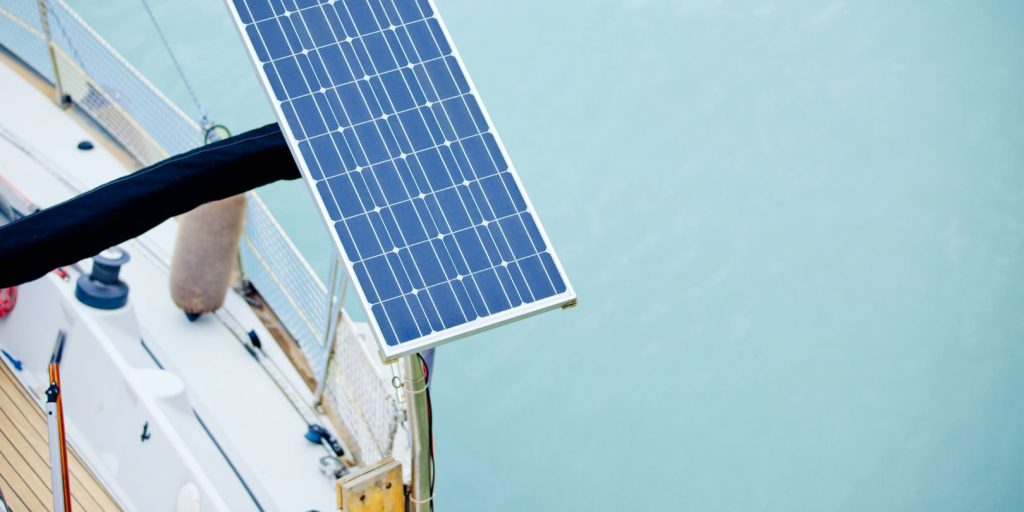
- 1 Monocrystalline Solar Panels
- 2 Polycrystalline Solar Panels
- 3 Thin-Film Solar Panels
- 4 Amorphous Solar Panels
- 5 Semi-Flexible Solar Panels
- 6 Rigid Solar Panels
- 7 Conclusion
Related Posts
As the world’s focus on sustainability intensifies, the allure of harnessing solar power for various applications, including marine settings, has grown significantly. For boat owners and enthusiasts, embracing solar panels offers a gateway to a greener and more self-sufficient way of navigating the open waters. The sun’s natural energy can power boats, reducing reliance on conventional energy sources and minimizing environmental impact.
In this blog, we delve into the diverse world of solar panels for boats , exploring the advantages and characteristics of each type. Whether you sail the vast ocean or cruise along tranquil rivers, understanding the array of solar panel options available will empower you to make informed decisions in embracing renewable energy and charting a course toward a more sustainable future on the waves.
Monocrystalline Solar Panels
Monocrystalline solar panels are known for their efficiency and sleek design, making them popular for boat owners seeking maximum power output in limited spaces. These panels are made from a single crystal structure, allowing them to convert sunlight into electricity efficiently. Monocrystalline panels boast an excellent power-to-size ratio, making them perfect for boats with limited roof or deck space. While they tend to be more expensive than other types, their durability and efficiency make them a wise long-term investment.
Polycrystalline Solar Panels
Polycrystalline solar panels are another prevalent option for marine applications. Unlike monocrystalline panels, polycrystalline panels have multiple crystal structures, slightly reducing their efficiency. However, they are more cost-effective to manufacture, making them a budget-friendly choice for boat owners. Polycrystalline panels are bulkier than monocrystalline panels, so they may require more space for installation. If you have ample deck or roof area on your boat and are looking for an economical solar solution, polycrystalline panels can be an excellent choice.
Thin-Film Solar Panels
Thin-film solar panels are highly versatile and lightweight, making them an attractive option for boats. They are created by depositing thin layers of photovoltaic material on various substrates, such as glass, metal, or plastic. Thin-film panels have lower efficiency than crystalline panels but perform better in low-light conditions, making them suitable for overcast or shaded areas on the boat. The flexibility of thin-film panels allows for easy installation on curved or irregular surfaces, making them an ideal choice for boat owners who value adaptability and space efficiency.
Amorphous Solar Panels
Amorphous solar panels, a subset of thin-film technology, are created by depositing non-crystalline silicon on a substrate. They are highly durable, lightweight, and flexible, making them a perfect fit for marine applications. Amorphous panels perform well in low-light conditions and have a better temperature coefficient than crystalline panels, meaning their efficiency drops less in hot environments. While they may have a lower efficiency overall, their ability to generate power in diverse conditions can be advantageous for long journeys or unpredictable weather conditions.
Semi-Flexible Solar Panels
Semi-flexible solar panels offer a middle ground between traditional rigid and thin-film options. These panels feature a thin layer of solar cells embedded in a flexible plastic or polymer material. Semi-flexible panels can conform to curved surfaces, making them suitable for mounting on boat decks, cabins, or sails. They are lightweight and easy to install, often requiring adhesive rather than bolts. While their efficiency might not match rigid crystalline panels, their versatility and ease of integration make them popular among boat owners.
Rigid Solar Panels
Rigid solar panels, typically monocrystalline or polycrystalline materials, are the most common type in various applications. While they are less flexible than other options, they remain a reliable and efficient choice for boats with ample deck or rooftop space. Rigid panels are durable, weather-resistant, and can deliver higher power outputs. They are ideal for boats with higher energy demands, such as those with multiple electronic devices or appliances.
Solar power is revolutionizing how we generate energy, and boats are no exception to this transformation. As boat owners seek eco-friendly and cost-effective solutions to power their vessels, solar panels offer a reliable and sustainable answer. Understanding the different types of solar panels available for boats is crucial in selecting the right solution for your needs, considering factors like space availability, budget, and desired efficiency. Whether you opt for monocrystalline, polycrystalline, thin-film, amorphous, semi-flexible, or rigid solar panels, embracing solar energy will propel your boat toward a greener and more independent future on the water.
Article Contributors
Sail magazine review team.
SAIL Magazine Review Team reports on best-selling products in sailing and boating. The SAIL Magazine editorial staff is not involved in the creation of this content. SAIL Magazine is reader-supported: When you buy through links on our site, we may earn an affiliate commission. The SAIL Review Team is composed of authors, editors, and sailors. Artificial Intelligence (large language models) may have been used in the research and creation of the content.
To ensure questions about product testing or a specific article are addressed, please contact [email protected]
- BOAT OF THE YEAR
- Newsletters
- Sailboat Reviews
- Boating Safety
- Sailing Totem
- Charter Resources
- Destinations
- Galley Recipes
- Living Aboard
- Sails and Rigging
- Maintenance
- Best Marine Electronics & Technology

Adding Solar Power to a Sailboat
- By Emily Fagan
- Updated: October 18, 2019
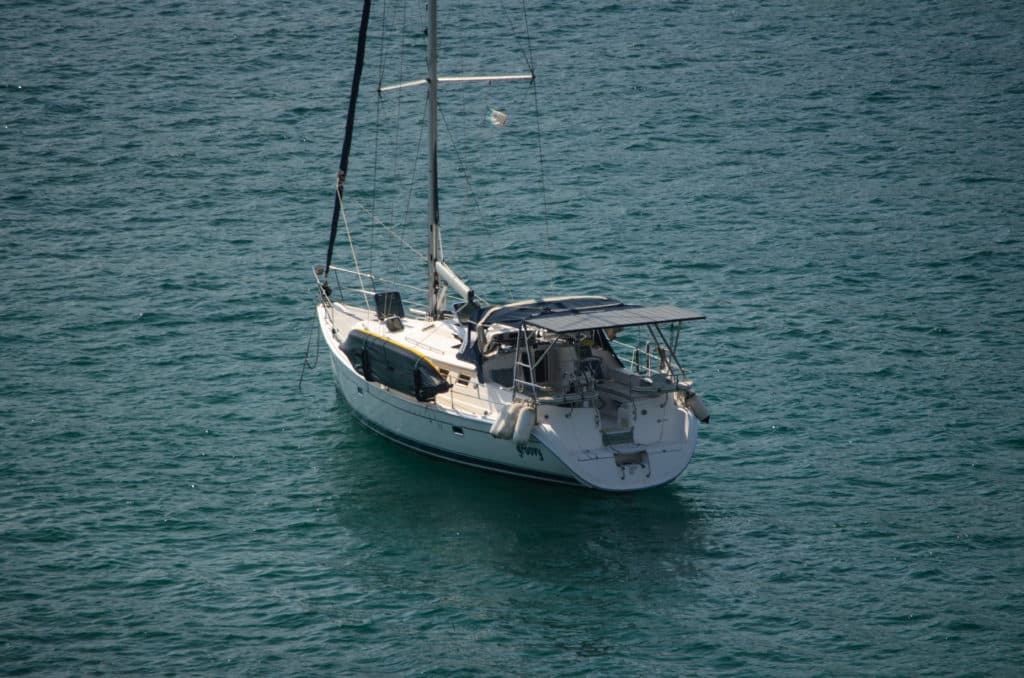
During our nearly four-year cruise of Mexico, my husband, Mark, and I lived almost exclusively on 555 watts of solar power charging a 640-amp-hour house battery bank. We anchored out virtually every night aboard our 2008 Hunter 44DS, Groovy , and relied on the sun for power. During one 10-week stretch, while we waited for a replacement engine alternator to arrive, our boat’s solar panels were our sole source of power. We had no backup charging system to turn to, and yet we lived and sailed comfortably the entire time. Mounting solar panels on a sailboat was not difficult, but a few key decisions made a huge difference in how effective our panels were.
A solar-power installation on a sailboat is made up of two independent systems: one system to charge the batteries, and another system to provide 120-volt AC power for household appliances. In the charging system, the solar panels convert sunlight into electrical current and deliver it to the batteries via a solar charge controller. Similar to a voltage regulator, the charge controller acts as a gatekeeper to protect the batteries from receiving more current than they need as they are being charged. In the AC power system, an inverter or inverter/charger converts the 12-volt DC power in the battery into 120 volts AC whenever it is turned on.
Panel Positioning and Wiring Considerations
One of the biggest challenges for sailors installing solar power on a sailboat is finding a place on the boat where the panels will be shaded as little as possible. Just a few square inches of shade on one panel can render that panel all but inoperable. Unfortunately, between the mast, radome, spreaders and boom, shadows cross the deck all day long, especially as the boat swings back and forth at anchor.
What’s worse, if the panels are wired in series rather than in parallel, this little bit of shade can shut down the entire solar-panel array. When we installed solar power on Groovy , we had already lived exclusively on solar power in an RV for over two years. Our RV solar panels had been wired in series, and we had witnessed the array shutting down current production when just half of one panel was shaded.
Choosing whether to wire the panels in series or parallel on a boat affects the wire gauge required, which is why many solar-power installers lean toward wiring the panels in series. Panels wired in series can be wired all the way to the solar charge controller with a thinner-gauge wire than those wired in parallel. This is because the voltage of panels wired in series is additive, while the current remains constant, so the current flowing is just that of a single panel. In contrast, the current flowing from panels that are wired in parallel is additive, while the voltage across them is not. This means that in a parallel installation, the current going to the charge controller is several times higher and requires much thicker cable to avoid any voltage loss over the length of the wire.
Not only is thinner-gauge wire less expensive, but it is also more supple and easier to work with, making the job of snaking it in and around various crevices in the boat and connecting it to the solar charge controller much less of a struggle. Thus the choice between series and parallel wiring boils down to a trade-off between system performance, expense and ease of solar system installation.
Luckily, the size of the wire can be reduced if higher-voltage solar panels are chosen. Since watts are determined by multiplying volts by amps, a higher-voltage panel that generates the same watts as a lower-voltage panel will produce less current. Therefore, selecting nominal 24-volt panels instead of 12-volt panels allows for the use of thinner wire sizes no matter how they are wired.
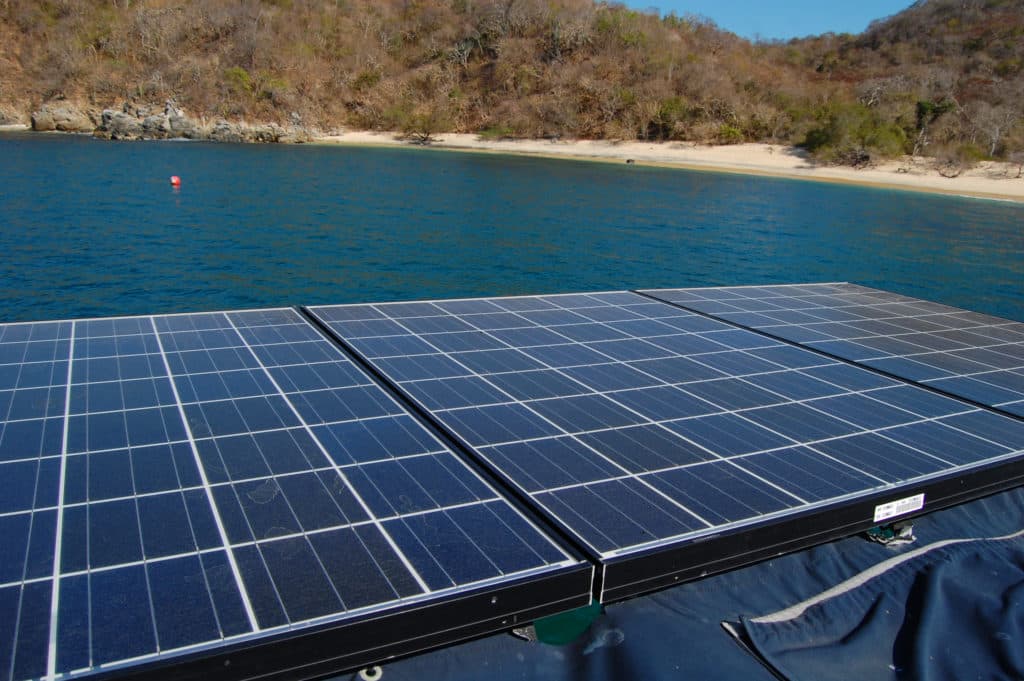
Our Marine Solar Panel Design Choices
In our installation, we decided to mount three 185-watt, 24-volt (nominal) Kyocera solar panels high above the cockpit, well aft of the boom, as far away as possible from potential shade. Our Hunter came with a big, solid stainless-steel arch, and we turned to Alejandro Ulloa, a brilliant metal fabricator at Baja Naval Boatyard in Ensenada, Mexico, to build a polished stainless-steel solar-panel arch extension onto the existing structure. He designed the arch extension with integrated telescoping davits to hoist our dinghy as well as support the solar panels. These davits were strong enough — and the lines and blocks had enough purchase — that either of us could lift our light Porta-Bote dinghy with its 6-horsepower outboard without a winch.
We spaced the panels about a half-inch apart and wired them in parallel. Using two twin-lead wires, we snaked the three positive leads and one common ground down through the inside of the arch tubes so they wouldn’t be visible, and placed wire loom over the exposed wires under the panels.
The junction points for the three parallel panels were on positive and negative bus bars inside a combiner box, all mounted in a cockpit lazarette. Inside the combiner box, we installed three breakers, one for each panel. This gave us the ability to shut off any or all of the panels if we needed to (we never did).
We mounted a Xantrex solar charge controller (model XW MPPT 60-150) in a hanging locker, as close to the batteries as possible, in a spot where it was easy to monitor and program. We ran twin-lead wire from the combiner box to the charge controller and from there to the batteries.
Our boat came with three new 12-volt Mastervolt 4D AGM house batteries, all wired in parallel, for a total of 480 amp-hours of capacity. We wanted a bigger house battery bank, and because it is best for the age, type and size of the batteries to be matched, we added a fourth new Mastervolt 4D AGM house battery, which brought our total to 640 amp-hours. Our batteries were installed at the lowest point in the hull, below the floorboards, and they ran the length of the saloon, from just forward of the companionway stairs to just aft of the V-berth stateroom door.
The best way to charge a bank of batteries that are wired in parallel is to span the entire battery bank with the leads coming from the charge controller. We did this by connecting the positive lead from the charge controller to the positive terminal of the first battery in the bank, and the negative lead from the charge controller to the negative terminal of the last battery. By spanning the entire bank, the batteries were charged equally rather than having the charging current focused on just the first battery in the bank.
We feel that AGM batteries are superior to wet cell (flooded) batteries because they can be installed in any orientation, don’t require maintenance, can’t spill (even in a capsize), and charge more quickly. Our Mastervolt batteries, like almost all AGM batteries on the market, are dual-purpose, combining the very different characteristics of both deep-cycle and start batteries. Our batteries work well, but if we were doing an installation from scratch today, we would consider the new Trojan Reliant AGM batteries. These batteries are engineered strictly for deep-cycle use and have been optimized to provide consistent current and maximize battery life.
Our boat came with a Xantrex Freedom 2,500-watt inverter/charger wired into the boat’s AC wiring system with a transfer switch. The inverter/charger performed two functions. While the boat was disconnected from shore power, it converted the batteries’ 12-volt DC power into 120-volt AC power, allowing us to operate 120-volt appliances, like our microwave. When the boat was connected to shore power, it charged the batteries.
Because this inverter/charger was a modified-sine-wave inverter, mimicking AC current with a stair-stepped square wave, we also had a 600-watt pure-sine-wave inverter to power our potentially more sensitive electronic devices. We chose Exeltech because its inverters produce an electrical signal that is clean enough to power medical equipment, and they are NASA’s choice for both the Russian and American sides of the International Space Station. For simplicity, rather than wiring the inverter into the cabin’s AC wiring, we plugged ordinary household power strips into the AC outlets on the inverter and plugged our appliances into the power strips. Like the charge controller, the inverter must be located as close to the batteries as possible. Ours was under a settee.
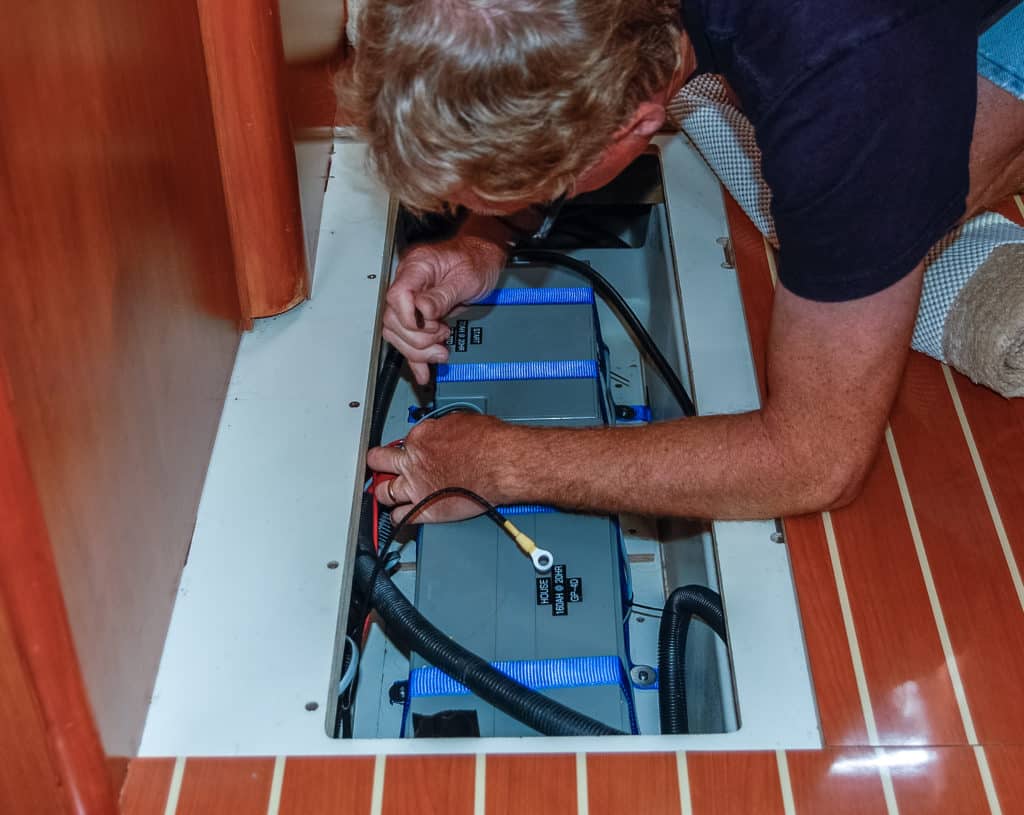
Shade’s Impact on Sailboat Solar Panels
Once our solar installation was completed on our sailboat, we closely observed the effects of shade on our solar-panel array. We were often anchored in an orientation that put the panels in full sun. Just as often, however, we were angled in such a way that shade from the mast and boom covered portions of our panels. It was fascinating to monitor the solar charge controller’s LCD display whenever the sun was forward of the beam — the current from the panels to the batteries fluctuated up and down as we swung at anchor.
Taking notes one morning, we noticed that the charging current was repeatedly creeping up and down between 9.5 and 24.5 amps as the boat moved to and fro. When the entire solar-panel array was in full sun, it generated 24.5 amps of current. When we moved so the mast shaded a portion of one panel, the array generated 15 amps. When it shaded portions of two panels and only one was in full sun, the array produced just 9.5 amps. Of course, it would have been preferable to see a steady 24.5 amps all morning, but this sure beat watching the current drop to zero whenever a shadow crossed a panel.
We discovered that shade makes a huge impact while sailing, too. Surprisingly, it is far worse to have the panels shaded by the sails than to have the panels in full sun but tilted away from its direct rays. One afternoon, we noticed that while we were on a tack that tilted the panels away from the sun, they generated 24.5 amps of current, whereas on a tack where the panels were tilted toward the sun but two of the three were partially shaded by the sails, the current dropped to a mere 10 amps.
Reflections On Our Solar Panel Installation
A wonderful and surprising side benefit of our large solar panels and arch system was that the setup created fabulous shade over the jumpseats at the stern end of the cockpit. Our metal fabricator, Alejandro, placed a support strut at hand-holding height, and sitting in those seats feels secure and comfortable while sailing, no matter the conditions.
After living on solar power for eight years of cruising and land-yacht travel, we’ve learned that you can never have too much solar power. Groovy’s 555 watts was enough to run all our household appliances as needed, including our nearly 4-cubic-foot DC refrigerator, two laptops, a TV/DVD player, and lights at night. However, it was not quite enough power to run all that plus our stand-alone 2.5-cubic-foot DC freezer during the short days and low sun angles of the winter months without supplemental charging from the engine alternator every few days. For the 10 weeks that we did not have a functioning alternator, our solution was to turn off the freezer, which enabled our batteries to reach full charge every afternoon.
Solar power made a world of difference in our cruise. Not only did it allow us to live comfortably and with ample electricity for weeks on end when our engine alternator went on the blink, but as a “set-it-and-forget-it” system, it also gave us the freedom to anchor out for as long as we wished without worrying about the batteries. In our eyes, the solar-panel arch enhanced the beauty and lines of our boat, giving her a sleek and clean appearance. It was true icing on the cake to discover that the panels and arch system also provided much-needed shade over the cockpit and helm from the hot tropical sunshine. If you are preparing for a cruise, consider turning to the sun for electricity and outfitting your sailboat with solar power.
The Installation:
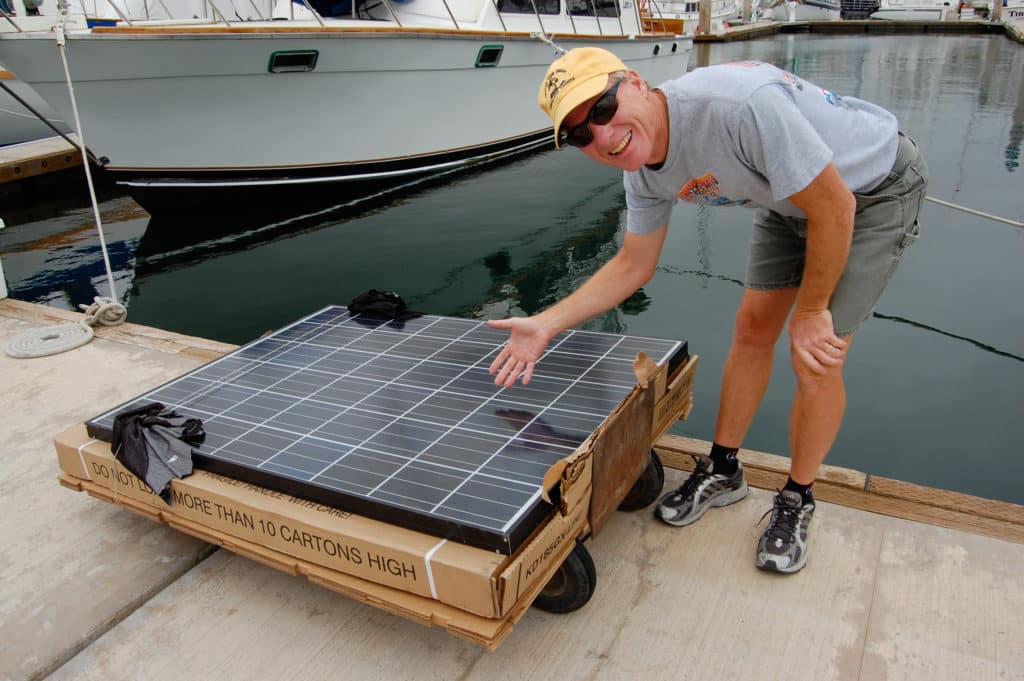
Emily and Mark Fagan offer cruising tips and share their stories and photos on their website, roadslesstraveled.us . They are currently enjoying a land cruise across America aboard an RV.
- More: DIY Sailboat Projects , green sailing , How To , installations , Refits , Sail Green , solar , solar panel , Upgrades
- More How To
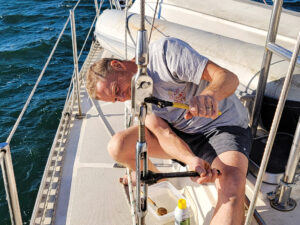
How to Rig Everything in Your Favor
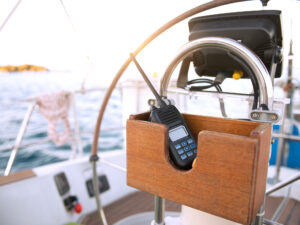
Is There a Doctor Aboard?

3 Clutch Sails For Peak Performance

It’s Time to Rethink Your Ditch Kit

Cruising the Northwest Passage

Balance 442 “Lasai” Set to Debut

A Legendary Sail

10 Best Sailing Movies of All Time
- Digital Edition
- Customer Service
- Privacy Policy
- Email Newsletters
- Cruising World
- Sailing World
- Salt Water Sportsman
- Sport Fishing
- Wakeboarding

The best of EcoWatch right in your inbox. Sign up for our email newsletter!
- About EcoWatch
- Contact EcoWatch
- Terms of Use
- Privacy Policy
- Learn About Solar Energy

Top 5 Best Solar Panels for Boats (2024 Marine Buyer’s Guide)
In this guide, you’ll learn:
- Why photovoltaic (PV) equipment is great to have on your boat
- Which panels are best suited for use on the water
- What qualities make for a great boat solar panel
Each product and or company featured here has been independently selected by the writer. You can learn more about our review methodology here. If you make a purchase using the links included, we may earn commission.
Why Should You Install Solar Panels On Your Boat?
Before we dive into the best panels to bring your boat into the world of clean energy, it’s worth discussing why you’d want a solar panel system on your boat in the first place.
There are a few use cases that are important to consider. These not only dictate whether or not you need panels on your boat, but they can also help you decide which system is the best and most cost-effective for you. We’ll discuss the different reasons to go solar on your boat below.

Blue Raven Solar

Regional Service
EcoWatch rating
Average cost
- Industry-leading in-house financing
- Competitive pricing
- Excellent reputation
- Doesn't offer solar batteries (coming 2022)
Charging Emergency Equipment
For anyone who has run into issues out at sea, the need for reliable emergency equipment is well understood. Whether you run out of gas, your boat breaks down or you have some other issue that precludes you from getting back to shore, having a way to reach out for help will keep your mind at ease.
Depending on the type of boat you have and how well it’s equipped, you may have a radio system, a satellite phone, a regular phone or some other communication device for emergencies. All of these require power, and having a solar system on your boat ensures that you’ll always have access to these devices.
Charging Recreational Equipment
Even if you’re not running into problems at sea, you might want the ability to charge recreational equipment. It’s always nice to have the ability to charge smartphones, e-readers, speakers and other devices you might use for entertainment.
This is especially important if you plan on spending a few days at sea and don’t want to rely on your boat’s batteries. Keeping those well charged for lighting, navigation tools and starting your boat’s engine is more important than getting your phone up to a full charge.
Quality of Life at Sea
For a lot of people, there’s a lot of joy in upgrading life at sea and making things just a little more comfortable. One of the perks of installing a solar system on your vessel is that you don’t have to worry about using your boat’s batteries for non-necessities.
For example, many recreational boaters connect their solar array to an electric cooler. Others use their solar modules to power electric water heaters for hot showers and constant hot water.
The possibilities for improving your at-sea experience with solar are really up to you, which is part of what makes bringing renewable energy to your boat so exciting.

What Are the Top 5 Best Solar Panels for Boats?
If you’re convinced you want to install solar on your boat, but you don’t know much about the available options, you might be overwhelmed by the choices. You’ll have access to seemingly countless brands and models.
To help you narrow down your options and choose panels that will meet your needs, we’ve done extensive research and chosen just a few product lines that we recommend. We’ll provide a quick breakdown of the different options below, and we’ll dive deeper into the specifications in later sections.
SunPower 170W Solar Panel
SunPower is a leader in the residential solar industry, so it’s no surprise that we found that the company also makes the best solar panels for use on boats.
This panel is pricey, but it’s significantly more powerful than most other options. At 170 watts, you can use these panels to charge your boat’s main battery, provide backup power for emergencies, or live large on the water by powering coolers, hot water heaters and much more.
This panel doesn’t come with a solar charge controller like many other options do, so not only is it expensive, but you’ll have to lay out more money for a controller, inverter and battery. However, we believe the efficiency and power output are well worth the investment.
These panels are also rated with a waterproof rating of IP67, which means they can withstand immersion in water up to about three feet for around half an hour. If you need more protection than that, you have bigger problems on your hands than losing a panel.
- High-efficiency panel for maximum power
- High-quality, durable materials
- Trusted and reliable brand
- Waterproof up to a meter for 30 minutes
- Doesn’t include any equipment other than the panel
Renogy 100W Flexible Marine Solar Panel
The Renogy Flexible solar panel designed specifically for use on the water is our pick for the best bang for your buck. It’s about half the price of the SunPower panel, although it does have a little more than just half the power capacity.
At 100 watts, this panel is great for middle-of-the-road power. It can serve as a reliable backup source of energy, or you can use it to recharge phones, GPS devices, e-readers, laptops and other electronics. It’s possible to use it for the quality-of-life items mentioned above as well.
This panel also has an IP67 waterproof rating, which is ideal for maintaining peace of mind on the water. Although it’s less expensive than our top pick, it includes a controller and wiring to connect your panels. You’ll just need an inverter and a battery to complete your setup.
- Excellent power output
- IP67 waterproof rating
- Includes controller and wiring
- Reliable brand name
- More expensive than many other options
- Doesn’t include a battery or inverter
EcoWorthy 25W Solar Panel Kit
The EcoWorthy solar panel kit is one of the easiest photovoltaic (PV) systems to install, so it’s our top pick for those looking to get started with clean energy. You can purchase this kit with a 10 amp-hour (AH), 12-volt battery, and the MC4 connectors are plug-and-play for a quick and painless installation.
This panel has a much smaller output than our top two picks, so it’s best reserved for backup power or for charging cell phones and other small electronics.
This kit has a waterproof rating of IP65, which means it can withstand being submerged in around five feet of water for up to a half hour, and it will also be protected from sprays of water. This is a great option for maintaining peace of mind when you’re on the water, especially if conditions are rough.
Lastly, the kit includes a panel, a controller and wiring, so you’ll just need to add a battery and an inverter to complete your kit.
- IP65 waterproof rating
- Includes a controller and wiring
- Very affordable
- Significantly less power than our top picks – Only ideal for light-duty use
NewPowa 30W Solar Panel Kit
This 30 watt solar panel kit from NewPowa includes a panel, a controller and wiring. If you add a backup battery and an inverter, you can create a complete off-grid solar kit for less than $150 without leaving your home (thanks to Amazon).
With an output of 30 watts, this is the best marine solar panel for light-duty use, although you could use it for non-essential electronics like an electric cooler or a small solar water heater. Those more demanding devices should be low-use, though.
The panels and controller are IP67-rated, so they’re suitable for use on just about any boat.
Best of all, the partial solar kit is just $60, so this makes our list as our top budget pick for going solar without breaking the bank.
The kit has pre-drilled mounting holes and is compatible with a wide variety of mounting brackets. As such, your installation process should be relatively straightforward.
- Includes a controller and plug-and-play wiring
- Relatively low wattage
TopSolar Monocrystalline Solar Panel Kit
The off-grid solar kit from TopSolar is a great affordable option, and it’s what we’d recommend as a starter kit for backup energy for beginners. It only puts out 20 watts, so this is not the best option if you’re looking for something to charge your recreational devices or quality-of-life equipment. However, it’s an affordable and easy-to-install kit for emergency power.
Unfortunately, this kit doesn’t include a specific ingress protection (IP) rating, but the manufacturer does note that the product is waterproof. Based on customer reviews, it appears that this product is safe for use on the water.
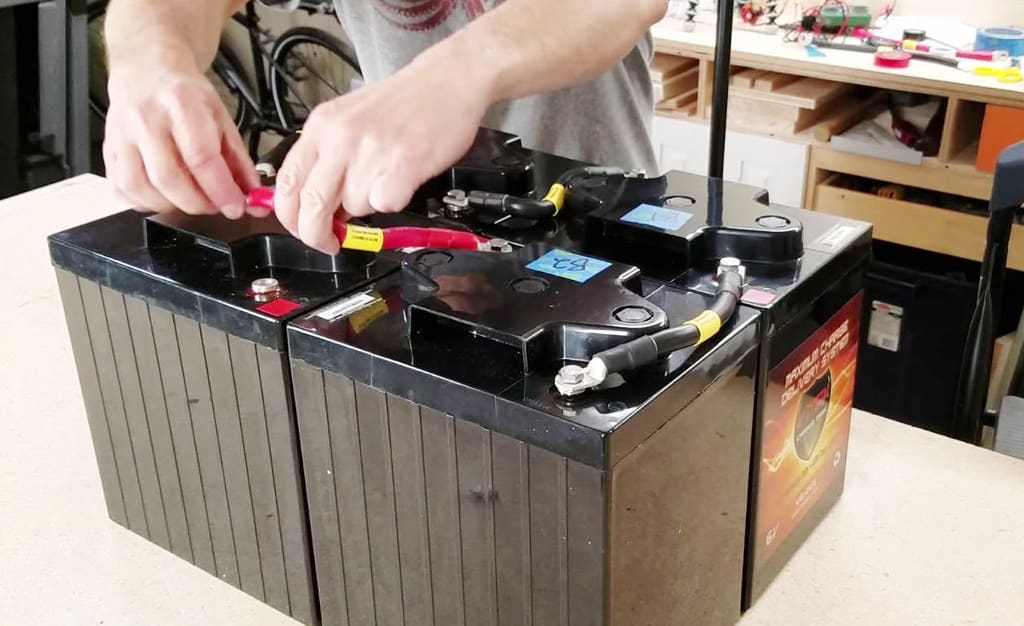
The kit includes a small PV panel, a controller and wiring, so you’ll need to buy an inverter and battery separately if you want AC power or backup power.
Best of all, the kit is super easy to install. It has pre-drilled holes and is compatible with most mounting brackets and clips.
- Great option for backup power
- Easy to install
- No official IP rating
- Low wattage
What Should Boat Owners Look for When Buying Solar Panels?
Solar panels can be a great option for marine use, but not all panels and solar kits are suitable for use around water. Additionally, the panel you choose needs to be selected based on how you want to use your solar power system.
In the sections below, we’ll include a few key things you’ll want to consider when choosing a solar module for your boat.
Energy Needs
One of the first things we recommend thinking about is how much energy you need your panels to generate. This will help guide you to what size panel and how much energy output you need.
If you’re just looking for reliable backup power for your boat’s internal 12-volt battery, or you want your panels to provide power for emergencies only, you’ll probably only need a panel of around 20 watts.
If you use your boat frequently for entertaining guests, or you spend days at a time on your boat, you might want something above 100 watts to provide backup power plus electricity for electric coolers, water heaters and more. Consider everything you’ll use your solar array for and size your system accordingly.
The chart below provides a quick breakdown of what size solar panels you need for different purposes on a boat.
If you plan on using your panels to replace an on-board generator, you can calculate how much electricity your boat uses and then size your system accordingly. It’s always advisable to go a little bigger than you think you need, as cloud coverage and the angle of the sunlight hitting your panels can cause fluctuations in solar power production.
If you have high energy needs, we also recommend considering a Maximum Power Point Tracker (MPPT) controller, which is more efficient than a Pulse Width Modulation (PWM) controller, which is more common.
Space Available for Installation
Just like residential solar systems are limited by available roof square footage, marine solar systems are limited by the available space for installation. This is an important consideration to make to ensure you don’t buy a panel that you won’t be able to mount or use in your vessel.
Before you buy any equipment, we recommend checking the measurements of the panel and deciding where on your boat you can install it. Some portable, foldable panels come with kickstands for temporary setups, but the smaller of our top picks can be set up just about anywhere without mounting brackets as well.
Type of Solar Panel
You’ll have a few choices for the type of panel you purchase for your boat as well.
First, you’ll need to decide between thin-film solar panels, polycrystalline solar panels and monocrystalline solar panels.
- Monocrystalline panels are the most efficient, so they’re the best suited for use on boats. The higher efficiency ratings will let you produce more energy per square foot, which is essential on a boat where space is limited. All of our recommendations above are monocrystalline.
- Polycrystalline solar panels can also work, but they won’t provide as much solar power.
- Thin-film panels are the most affordable, but they generate even less electricity and aren’t ideal for use where available space is minimal.
Second, you should think about whether you want a rigid solar panel with an aluminum frame or a semi-flexible one. Flexible panels contain special solar cells that can be a bit pricier, but they’re easier to install and are a bit more versatile. They can be mounted on curved surfaces, giving you more placement options.
Waterproof Rating
Since you’ll be using your panels on the water, it’s essential that you choose one with a good waterproof rating. Some of the best options are IP67 and IP65. These will ensure your panels and charge controllers or regulators remain safe and at low risk of fire even when exposed to moisture and direct water contact.
Accessories
Finally, you should consider what your kit comes with. Some come with only panels, so you’ll need to buy a controller, an inverter and a battery to complete your setup. Some come with a combination of these parts, although batteries and inverters aren’t commonly included. Some panels also include mounting brackets, although this is also uncommon.
Thinking about the additional equipment you’ll need to purchase after buying your panels will help you budget more effectively for your entire system.
How Do Solar Panels Work With Boats?
PV panels for boats work just like panels for residential use — they collect sunlight and route the energy either to a storage or use system.
Since boat solar systems are entirely off-grid, most require the following:
- Solar panels
- A charge controller
- An inverter
- Mounting brackets or other mounting hardware
- A backup battery for energy storage
We’ll explain what each of these components does in the section below, and then we’ll get into how to set up and maintain your system.
Equipment for a Marine Solar System
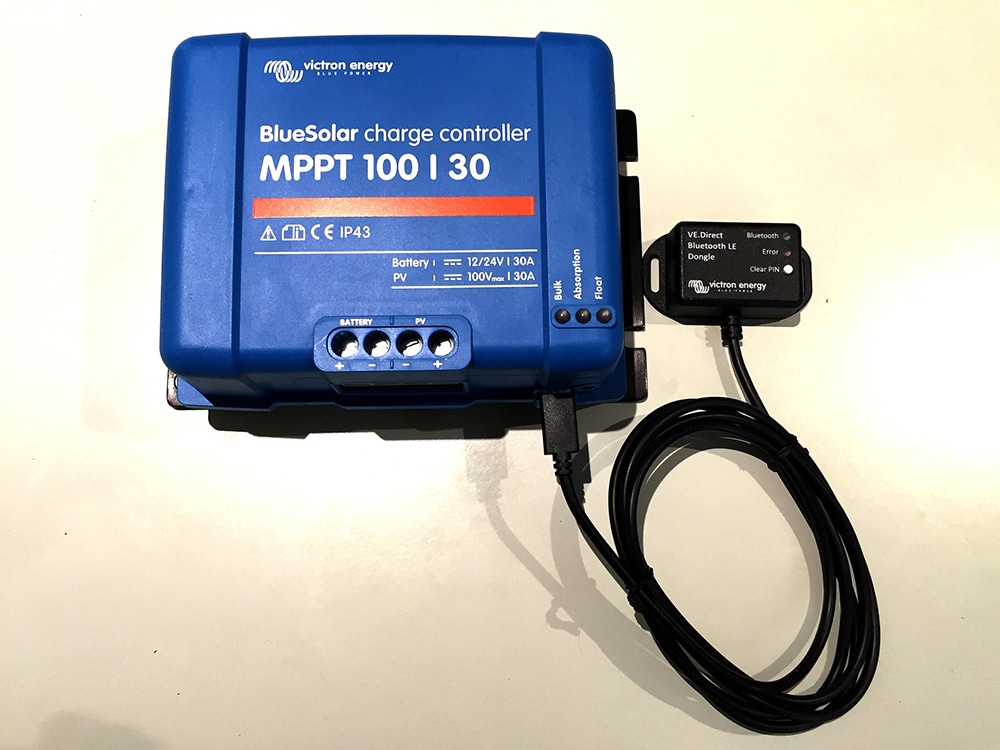
The main components you’ll absolutely need for your boat solar system are PV panels and a controller. If you plan to store energy or use it to charge common electronics, you’ll also need a battery and an inverter.
The panels are the pieces of the system that collect energy from the sun. The electricity generated is then passed to your controller, which limits the amount of power that flows through the wires to your battery or device.
The charge controller helps prevent overcharging batteries or electronics when production is high, and it also prevents battery drainage when production is low. Some panels are equipped with bypass diodes to provide the same safety features.
The solar energy that’s collected is direct current (DC), while most electronics, including standard light fixtures, use alternating current (AC) power. An inverter is used to convert DC current to AC so that you can use your solar power to power devices directly. If you don’t have DC lights in your boat, for example, an inverter might be necessary to provide lighting.
A battery storage system is exactly what it sounds like: it’s a battery bank that stores solar energy for later use.
Solar batteries are useful for two main reasons on boats.
- First, if you ever experience cloudy days, your solar production might very well drop below what you need to provide power to your devices. In that case, having a battery to pull stored energy from can be helpful in maintaining charging capability or electricity.
- Additionally, a battery on board can be useful for maintaining backup power for emergencies. If your boat’s built-in battery ever fails or you need to charge emergency communication or navigation devices, a battery will come in handy.
Installation
Since you want your solar panels to be exposed to as much sun as possible, it’s best to install them at or near the highest point on your boat — often the bimini. This will prevent them from getting shade from other parts of your boat during the day, regardless of which direction your vessel is moving.
It’s also typically best to install your panels as close to parallel with the surface of the earth as possible. Since your boat will be moving around a lot, it’s not realistic to install them facing the path of the sun in the sky as you would on a home. Laying them flat gives you the best chance of always collecting at least some sunlight.
You, of course, need to consider available space as well, so remember to take measurements of your installation site and compare them to your panels before beginning the process.
Finally, you should consider where your batteries will be — if applicable — and where your wiring will run once your installation is complete. Keeping these things in mind will help ensure that the installation process goes as smoothly as possible.
Below, we’ll include a brief step-by-step guide on how to install a solar system on your boat.
- First, take measurements of where your panels will be installed, the path the wiring will take to all components and where your battery, inverter and controller will be placed. Making sure you have enough room for all of your components will help avoid headaches once you get started.
- We recommend mounting your batteries, inverter and controller first. These are generally the easier components to mount, so they’re the easiest to move once installed.
- Next, mount your panels. The process for this will depend on the panels you choose and where you plan to install them. You should follow the installation instructions for the mounting brackets or hardware you purchase.
- Finally, you can wire your system, beginning with the connection between the panels and the controller and then the connections to the inverter and battery.
- You can test your system by using a voltmeter or by checking to see if your powered devices function as intended. Some controllers will also show you if your panels are providing energy and how much they’re producing.
For more guidance and information on how to set up your boat solar system, you can check out the video below:
Maintenance
Thankfully, solar systems are relatively maintenance-free once installed, although you should carry out routine system checks and cleaning to ensure you continue to enjoy maximum safety and energy production.
You should spray down your panels with water about once every six months to get any accumulation of dirt or salt off of them. This will help maximize energy generation. Around the same time, you should also check the wires and connectors for corrosion, which is more likely to occur if you use your boat in saltwater.
After major storms, it’s a good idea to ensure that none of the connections between components were lost. A simple disconnect could lead to your battery charging issues, which could be an issue if you ever need backup power.
Lastly, it’s worth mentioning that solar systems on boats are generally considered safe. There is a small risk of fire but provided you carry out the proper maintenance, you should avoid any serious issues.
Are Marine Solar Panels Worth It?
The answer to this question really depends on who you ask. For some boat owners, PV panels are essential. Not only can they provide backup power for emergencies, but they can also improve your quality of life at sea and the enjoyment of your boat.
For many people, these things are indispensable, so solar systems are well worth the investment. For certain types of boats — like small fishing boats and sailboats — solar panels will be the only source of electricity.
Other boat owners feel comfortable relying on generators if they have them, and some use their boats only for short durations, which makes having an on-board solar array less valuable.
For most people, though, having at least a small solar system to provide backup power for emergencies is worthwhile. From there, opting to up the size of your system to improve your time at sea isn’t hard to get behind.
FAQ: Marine Solar Panels
Below, we’ll answer a few of the most common questions we get about solar panel systems made for boats.
What are the best marine solar panels?
In our opinion, the best solar panels for boat use are the SunPower 170W solar panels. These are flexible panels that allow for easy and versatile installation.
They are some of the most efficient panels suitable for boat use, and they provide an incredible 170 watts each. This is enough power for just about anything you need electricity for on your boat and for emergency equipment in low-light conditions.
These panels are a bit expensive, and they don’t come with any additional equipment. However, the junction boxes have a waterproof rating of IP67, come with a five-year warranty for equipment and high efficiency and are made from high-quality, durable materials for years of use.
Will solar panels keep my boat battery charged?
Yes, solar panels can be hooked up to keep your boat’s 12 volt battery charged. However, you need to make sure you install a system that is sized appropriately for your boat’s needs.
You can check how much power your boat draws from its battery system by looking at the loads (in amps or watts) of each device. You can also use your battery monitor if you have one to check the energy demand of each individual component pulling power. Then, choose solar panels that produce a bit more energy than your system needs.
If you live in an area that experiences a lot of cloudy weather, you might want to size up your system even more to ensure your system generates enough electricity.

How much does it cost to put solar panels on a boat?
The cost to install a solar array on your boat can range from around $150 up to well over $1,000. Where in this range your total falls depends primarily on how much energy you need to produce.
If you’re looking for portable solar panels to take on and off a small boat with you for emergency use only — which is typical for sailboats and smaller boats that don’t normally have electricity — you’ll likely be looking at the $150 end of the spectrum.
If you have a much larger boat and want to be able to maintain power for your essential equipment and some non-essentials, then you’ll likely push your all-in cost closer to the higher end of the range.
What are the benefits of solar panels on boats?
Installing solar panels on your boat can provide quite a few key benefits, although the perks you’ll actually experience depend on your situation and your specific boat.
Perhaps most importantly, solar panels can charge your boat’s battery and maintain electricity for emergencies. Most systems — even small ones — can serve to charge your phone, GPS or other emergency devices in case you run into problems out on the water.
Larger systems can also provide power for recreational use, like charging phones, powering speaker systems, keeping beer cold and more.

Related articles
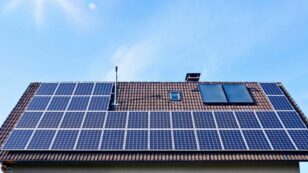
Calculate Your Solar Panel Payback Period (How Long To Recoup Costs?)

Solar Panel Cost In 2024 (Homeowner’s Installation Savings Guide)
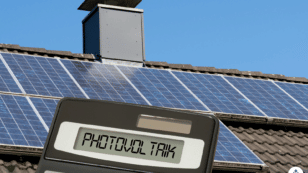
Solar Calculator
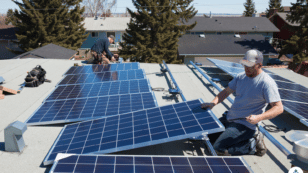
Top 6 Best Solar Companies Review
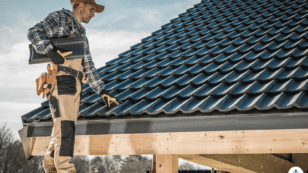
Solar Roof Shingles 2024 Cost and Buying Guide
Related Solar Panel Guides
- Buyer’s Guide: Best Solar Panels for Camping (2022)
- 7 Best Solar Panels for Mobile Homes (2022 Guide)
- What Are the Best Solar Panels for Farming Solar for Agriculture Guide (2022)
- The Best Solar Panels for Portable Solar Generators
- 5 Best Flexible Solar Panels (2022 Reviews and Buyer’s Guide)
Comparing authorized solar partners
Having trouble deciding? Click below and use our process to receive multiple quotes instead:
Updated 1 month ago
Everything you need to know about installing solar panels on boats
Written by Ana Almerini
Find out what solar panels cost in your area
Solar panels built specifically for use on boats are a great option as a source of backup power when you’re out on the water. Solar panels act as a way to recharge the boat's batteries and keep your appliances running, all without needing to buy gas for a noisy gas-powered generator.
Marine solar panels are a relatively niche market, but there are plenty of options to choose from since typically, you can install any DIY off-grid solar panel on your boat.
Our favorite solar panels for boats are:
Topsolar flexible solar panel
Renogy 100W 12V solar panel
SunPower 170W solar panel
Below, we get into the best solar panels to buy for your boat depending on your needs, how to determine which size you will need, and why utilizing solar power for your boat is a smart idea.
Key takeaways
Solar panels on your boat maintain your battery’s charge to ensure that your appliances always have power, without a loud and expensive gas generator.
An average 30-foot boat will need about 350 watts of solar power to maintain electricity.
To determine how many panels your boat needs, you need to figure out how much power it uses, which you can easily do with a battery monitor. It also depends on how big your boat’s battery is.
You can install solar panels in unique locations on your boat but it is important that they can track the sun’s movement throughout the day.
What is the best use for boat solar panels?
Boats use a lot of energy for things like maintaining autopilot, keeping navigation lights on, and powering radio systems. Solar panels can provide the energy to carry out these tasks and maintain your boat's battery if it happens to be sitting idle. In either circumstance, your battery will never run out of energy.
Not to mention, compared to gas-powered generators, solar panels have the added benefit of being quiet. They also don’t produce excess heat that makes sitting in your boat with a gas generator unpleasant on hot days.
You can use solar panels for any size boat. For smaller sailboats, the main job of your solar panels would be to keep the battery fully charged for your boat’s electricity. For larger boats, they help reduce or eliminate the need to use the engine to provide excess power.
The average 30-foot boat would require about 300-350 watts of power . Depending on your energy use and boat size, you need more or less solar power to provide you with electricity.
How to choose the right solar panels for your boat
The first step to determining what size solar panel will work for your boat is figuring out how much power your boat is using . You can do this by checking the labels on your appliances for the typical amp hours and volts used.
Or, you can use a battery monitor to measure the amount of energy your fridge, lights, or the other appliances on your boat consume while in use. After finding the amp hours your boat uses per day, you can determine the wattage of power your solar panels need to produce.
This example is extremely limited, you will need to determine how much energy your entire boat is using to make sure your panels provide enough power to keep your battery charged. But, technically if you had one 300-watt solar panel, or (3) 100W solar panels, they would generate 2,800W over those 8 hours. That energy would be more than enough to keep the above appliances running.
The size of your boat’s battery will also factor into which size solar panel you need . For instance, many DIY solar panels are meant to act as a battery charger to a 12-volt lithium battery, which is the typical size within a boat. But if you have a larger boat with a larger battery, you might need more than 350 watts of power.
Additional things to consider are whether you will need a charge controller and if you have enough unshaded space for your solar panels to absorb the maximum amount of sunlight.
Do you need a charge controller?
A charge controller acts as a regulator for the amount of energy that is transferred from your solar panel into your boat’s battery. This helps to make sure that your battery is not overloaded and overcharged, which can ruin the battery over time.
While it is not necessary, it is a good idea to install a charge controller with your solar panel system to help manage the energy load that your battery receives. This will prolong the life of your battery while ensuring your boat uses the exact amount of energy it needs.
Do you have enough space for boat solar panels?
Having a dedicated spot on your boat that has access to the full sun is key. Any shading, such as from a sail on your boat, will reduce the amount of energy your panels produce. While simply bringing portable solar panels aboard is an option, permanently mounting the panels to your boat makes it easier to always have your panels ready to go.
Because boats typically only have room for a small solar system, getting the most out of your limited space is key. With limited space, it’s best to look for high efficiency panels because you will need less of them to produce the energy you need.
Learn more : What are the most efficient solar panels in 2022?
Or something as simple as the setup below can power your boat's battery and be angled towards direct sunlight throughout the day while not taking up valuable space on the boat.
What are the best solar panels for boats to buy?
Any type of panel can be used on a boat such as monocrystalline, polycrystalline or thin-film. However, it is important to note that some companies exclude salt water and marine environments from their warranties.
We've listed some options below, you can choose based on where you have space to put the panels. For instance, thin-film panels are less efficient but they are flexible. So if you wanted to place a few panels on your boat’s roof versus one panel taking up valuable space, thin-film panels would be a good choice.
On the other hand, monocrystalline and polycrystalline panels have higher efficiency ratings and will ensure you get the most energy from your limited space or during low-light conditions. So if you have a location that can support racking, monocrystalline or polycrystalline solar panels are a better option.
Below are some of our top picks for solar panels for boats:
Most practical
Topsolar flexible solar panel
Cost : $149.99 Buy Now
The Topsolar 100W flexible solar panel is a practical, semi-flexible, cheap option. It does not come with a charge controller or an inverter but you can buy a few of these to create a simple solar panel system on your boat.
This flexible panel also allows you to utilize more space since this can be molded to fit untraditional angels on your boat.
Best quality, small cost
Renogy 100W 12V solar panel
Cost : $103.44 Buy Now
The Renogy 100W 12V solar panel is a great option. At 21%, it is a high efficiency monocrystalline panel manufactured by a reputable solar panel company.
There are pre-drilled holes for easy drilling to a mount on your boat. If you have space to secure solar panels to a mount, the Renogy panels will help you maximize energy output.
Best overall
Cost : $399.00 Buy Now
The SunPower 170W panel is a great flexible solar panel for off-grid use. Choose this option if you are interested in the versatility that a flexible solar panel offers and also want a reputable brand name with a high efficiency rating.
While these panels do not come with a solar charge controller, they must be used with one, so add one to your cart like the Victron Energy SmartSolar MPPT charge controller .
Why solar panels are a good choice for backup power on boats
Having a source of backup power on a boat is very important, you do not want to be caught far from land with a dead battery. Solar energy is the perfect choice because on a typical boating day, there is ample sunlight available as renewable energy. Because boats rely on a battery for electricity, a solar panel can ensure that this battery always has power.
There are many solar panel options available for your boat and can easily be installed DIY. They will help with your sense of security while saving money because you can skip out on the traditional gas generator and rely on a self-sufficient solar power system.
Ana is the Marketing & Communications Manager at SolarReviews, working within the solar industry since 2020. With a Master's in Climate and Society and professional experience in marketing, she helps communicate the value of solar to homeowners and build awareness of the SolarReviews brand. On weekends you can find her at the Jersey shore, reading a book from the ever-increasing stack on her side table, or eating food someone else cooked....
Related articles
- Subscribe Now
- Digital Editions
Best boat solar panels: 6 options for boosting your yacht’s power
- Phil Sampson
We take a look at 6 of the best solar panels for boats, from folding units to cutting-edge flexible panels

Free power forever? If only it was that simple! Photo: Graham Snook
For many in the boating community, boat solar panels represent something of a holy grail. They are, after all, the gift that keeps on giving, aren’t they? Free power forever, (or many years anyway), coupled with zero running costs – what could possibly be better than that?
All you have to do to make this dream come true is banish the memory of the purchase price from your mind – something boaters are notoriously adept at doing – and wait for the sun to shine. If only it were that simple…
The fact of the matter is that there are costs associated with boat solar panels beyond the price of the panels themselves. While some types of panels can be simply laid on the deck, in many cases some form of mount will be required.
Then there’s the wiring to hook them up to your battery, plus any fitment and/or cosmetic work needed to hide the cabling from view. If your panels are to be left connected permanently, you’ll require a regulator too.
This will prevent both overcharging and a reverse flow of power out of the battery after dark. If you do not fit a regulator, a blocking diode can be used to halt the reverse flow instead.
But once all of the above have been overcome – and providing you’ve done your homework to ensure your panels will generate sufficient power to cover your needs – then, yes, it’s a power free for all!
There are many other benefits to boat solar panels too: First and foremost, they work all on their own – solar panels are automatic, so you can just let them get on with the job.
Apart from the occasional wipe over and a wiring check, they’re largely maintenance-free too. Unlike wind generators, (especially like the one with wonky bearings on that boat moored next to you), they don’t make any noise.
And finally, your battery will be pleased, because keeping it from going flat can extend its life.
Here’s our choice of the best boat solar panels.
6 of the best boat solar panels available right now

Giosolar 1,000W flexible solar panel
Best flexible boat solar panel
Delivering a mighty kilowatt of power, (not far off the amount used by a one bedroom house), this Giostar package comprises ten separate 100W panels, each of which is 1,050 x 540 x 2.5mm in size.
Capable of charging either 12 or 24V batteries, a kit of this magnitude is one for the most serious of solar enthusiasts – Eco Experts reckons 660-990W is sufficient for a liveaboard.
Giostar panels are abrasion resistant, anti-rust and dust proof and their junction boxes are sealed and waterproof. The panels are also light, thin and flexible, and can withstand being bent up to 30 degrees.
Price: £1,464.45
Buy it now on Amazon (UK)
Note: We may earn a commission when you buy through links on our site, at no extra cost to you. This doesn’t affect our editorial independence.

Mobisolar 100W foldable solar panel
Best foldable boat solar panel
Mobisolar’s foldable panels are light (4.5kg) and measure 121 x 56.5 x 3 cm when unfolded, with the longest dimension reducing to 60 cm when folded, making them easy to transport.
The panels use advanced technology to provide superior performance, with each panel subjected to a thorough testing routine before and after assembly.
So confident is Mobisolar in its products that the company stands behind its panels with a two-year defect warranty and a five years’ electrical performance warranty.
For maximum flexibility in operation, three USB power outputs are fitted per panel, one delivering 100W, the second 60W and the third 10W.
Price: £145.00
Buy it now on eBay

Eco-worthy 100W solar panel kit
With 100W panels being ideal for keeping batteries topped up, our second offering in this power class is from Eco-worthy, a major player in the solar panel field.
Competitively priced, our link below is for a kit which includes an LCD control unit and four ‘Z’ brackets in addition to the panel itself.
The Eco-worthy 100W panel is of the monocrystalline type, which means their cells are made from an ingot grown from a single silicon crystal of high purity. It’s also a rigid panel, so this particular product would need to be mounted on a frame or flat surface.
Price: £113.99

PV Logic 20W Flexi solar panel
Offered by Force 4 Chandlery, this lightweight semi-flexible solar panel comes complete with a dual battery solar charge controller.
The panel is completely waterproof thanks to its six-layer, heavy-duty laminate finish, and should a wayward crew member plod over it in their size 9s the panel’s dimpled top surface is ‘self healing’.
The controller can handle both 12 and 24V systems and the panel’s PWM (Pulse Width Modulation) charging system is efficient and battery-lifetime friendly.
Supplied with LED battery-status indicators and 4 metres of cable, PV Logic Flexi panels can be bonded to flat or curved surfaces.
Price: £149.95
Buy it now on Force 4 Chandlery

Powoxi 10W solar panel
At the budget end of the market comes this Powoxi 10W solar panel charger kit. While you won’t go far on just 10W of power, this kit claims to be capable of charging and maintaining various 12V batteries.
The kit features a fully automatic charging and maintenance controller, which provides intelligent three-level charging and protection against short- and open-circuits, under voltage and overloading.
A reverse flow system is included and the interface is described as ‘plug and play’. While the panel is rainproof, it will not withstand immersion in water, so this is a product to perhaps leave behind on the dock when you take to the water.
Price: £27.59

Eco-worthy 10W/5W solar panel
The least pricey option we could find anywhere, this baby 5W solar panel is simply a trickle charger. But if that’s all you need then look no further, for this is another Eco-worthy product.
The technology in the panel is polycrystalline, so it’s not the most efficient on the market, but for this power that’s hardly a great concern.
The panel is supplied with two charging options; a pair of crocodile clips which attach directly to the battery, and a cigarette lighter plug.
According to the product’s eBay listing, this seller alone has sold approaching 3,000 of these units – and at this price, we can understand why!
Price: £9.99
- Articles and Guides
The Best Solar Panels for Boats, Top Brands on the Market
29th jan 2024 by denelle balach.

Energy generated by solar systems converting sunlight into energy for electrical needs has made dramatic gains worldwide in the last 15 years. However, until relatively recently, solar panels that could withstand the harsh marine environment were just a dream.
Fortunately, a new reality has emerged. The boating community can now choose from numerous solar brands that fit any person’s boat, budget, and power needs without skimping on safety, durability, and efficiency. Solar panels are a clean, renewable source of power that will reduce or eliminate the need for fossil fuels aboard your boat, potentially saving on fuel costs in the process, but that’s just one benefit.
Solar doesn’t produce greenhouse gas emissions, resulting in less pollution and a reduced carbon footprint from your boat. Solar panels operate silently, providing a quieter and more peaceful boating experience. They offer freedom from shore power and generators so you can stay on the water longer before needing to turn on your engine or return to shore to recharge your batteries. Solar panels are generally low maintenance and are regarded as a reliable, hassle-free power source.
They are long-lasting especially when classified at an IP67 (ingress protection) rating. This ensures they are protected from water corrosion. They are versatile in size and configuration and can be installed on most boat sizes and types. Some great mounting options include on the deck, atop a cabintop, bimini or arch, or even integrated into the sails of a sailboat.
However, choosing the right solar panels for your boat can be confusing, and with significant upfront costs, it’s understandable that you want your first solar panel purchase to be a good one!
Below are some of the top marine solar brands that you can depend on for efficiency, durability, and affordability, as well as some things to consider before purchasing any solar panel(s).
Best Premium Solar Panels
Now owned by Maxeon, SunPower has consistently dominated the residential solar panel market, so it’s no surprise many boaters consider them an excellent option for their vessels. SunPower is a premium solar brand with the highest power output and charging capacity in its product class. This means more power in less space! SunPower is made from lightweight polymer materials within their flexible and fixed-frame options.
SunPower has a robust 25-year warranty, claiming specific modules will be at least 80 to 92 percent of the minimum peak power rating after 25 years. SunPower’s commitment to innovation and cutting-edge technology makes their solar panels an excellent choice for any boat’s size and power needs, as they have many sizes, wattages, and types of solar panels.
SunPower panels are usually more expensive than other solar panels on the market. However, their panels are highly durable and efficient. The other challenge for some consumers is that SunPower does not sell directly to marine consumers from their website. To purchase one of their panels, you must contact a dealer such as Sun Powered Yachts or purchase a panel from Amazon. Sun Power’s official customer service is only trained in residential and commercial solar systems, so they cannot answer marine-specific questions. Sun Powered Yachts Website
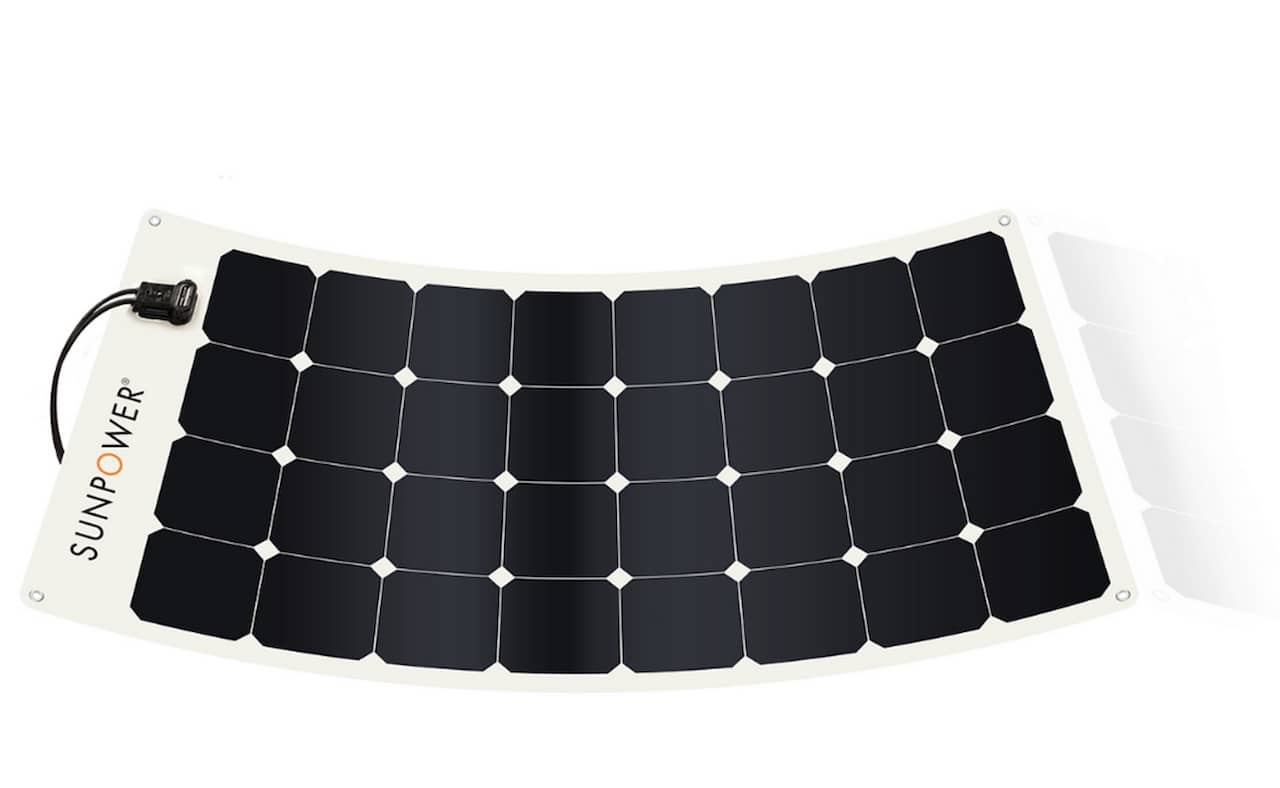
Sunpower SPR-E-Flex-100. Sunpower photo.
Solbian is a premium solar brand specializing in flexible and semi-flexible solar panels. They guarantee the quality of the product and its duration in time. Most of their panels use SunPower’s technology to make their cells. Solbian’s panels are durable, thin (less than 2mm), and have flexible, curved surfaces, perfect for any boat deck. Their panels are lightweight, about 2.5 kg per square meter, compared to the average 12 kg in traditional panels. Solbian’s solar cells are remarkably efficient as they are manufactured in the SP series, which can give out high power in tiny dimensions.
Solbian modifies the number of cells, color, shape, and electrical characteristics to get your panels exactly how you want them. They are easy to install, both permanent and removable, and are often mounted via a structured adhesive, making installation easy. These are more expensive than other flexible and semi-flexible solar panels, but considering their efficiency and longevity, these panels will provide a good return on your investment in the long run.
Another problem buyers face is purchasing knock-off Solbian panels from scam manufacturers. You’ll know this is the case when your panel says they are an “A” grade panel. Solbian and SunPower don’t use industry grades! These vendors may also use a variation of SunPower’s or Solbian’s name, like “Solbien,” to scam people. Solbian’s Official Website
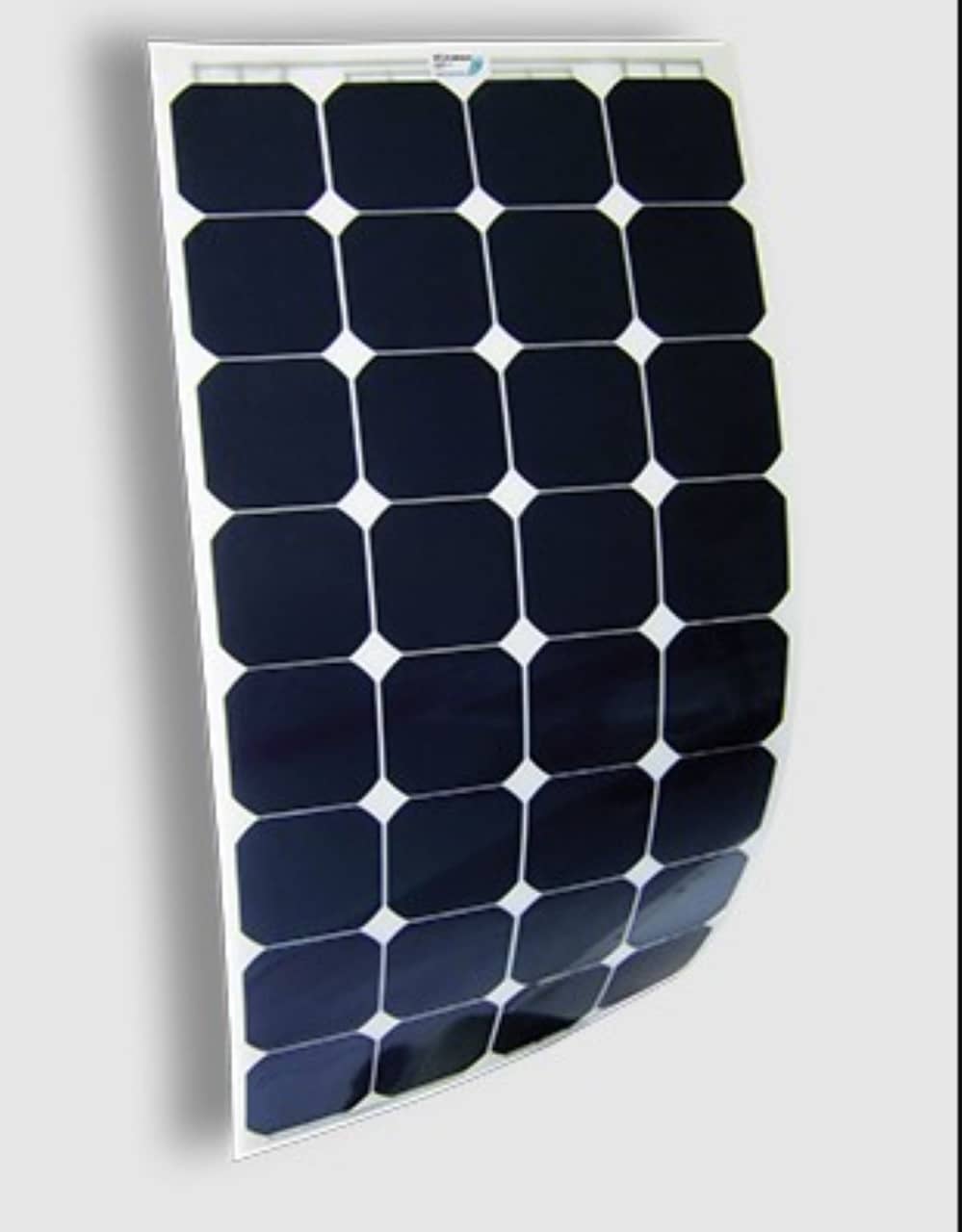
Solbian SP Series. Solbian photo.
Best Overall Solar Panels
Renogy provides a wide range of solar panels suitable for various boat applications. The brand has established a reputation for its durable, efficient panels offered at a lower price than competitors like SunPower. With numerous options available, Renogy allows you to choose the ideal size and type of solar panel tailored to your boat’s needs.
The company offers plenty of resources and videos to aid in selecting the best panels and facilities for easy DIY installations, often requiring no drilling holes. Their panel options come in flexible and fixed-frame shapes, available in various sizes and wattages. However, while these are competitively priced, they are slightly less efficient than premium alternatives like SunPower, potentially necessitating the purchase of more or larger panels for equivalent energy capture.
Some reviews also indicate that due to Renogy’s rapid scaling, they have had challenges in maintaining strong customer service. This could result in poor user experience or issues with warranty returns. Renogy Official Website
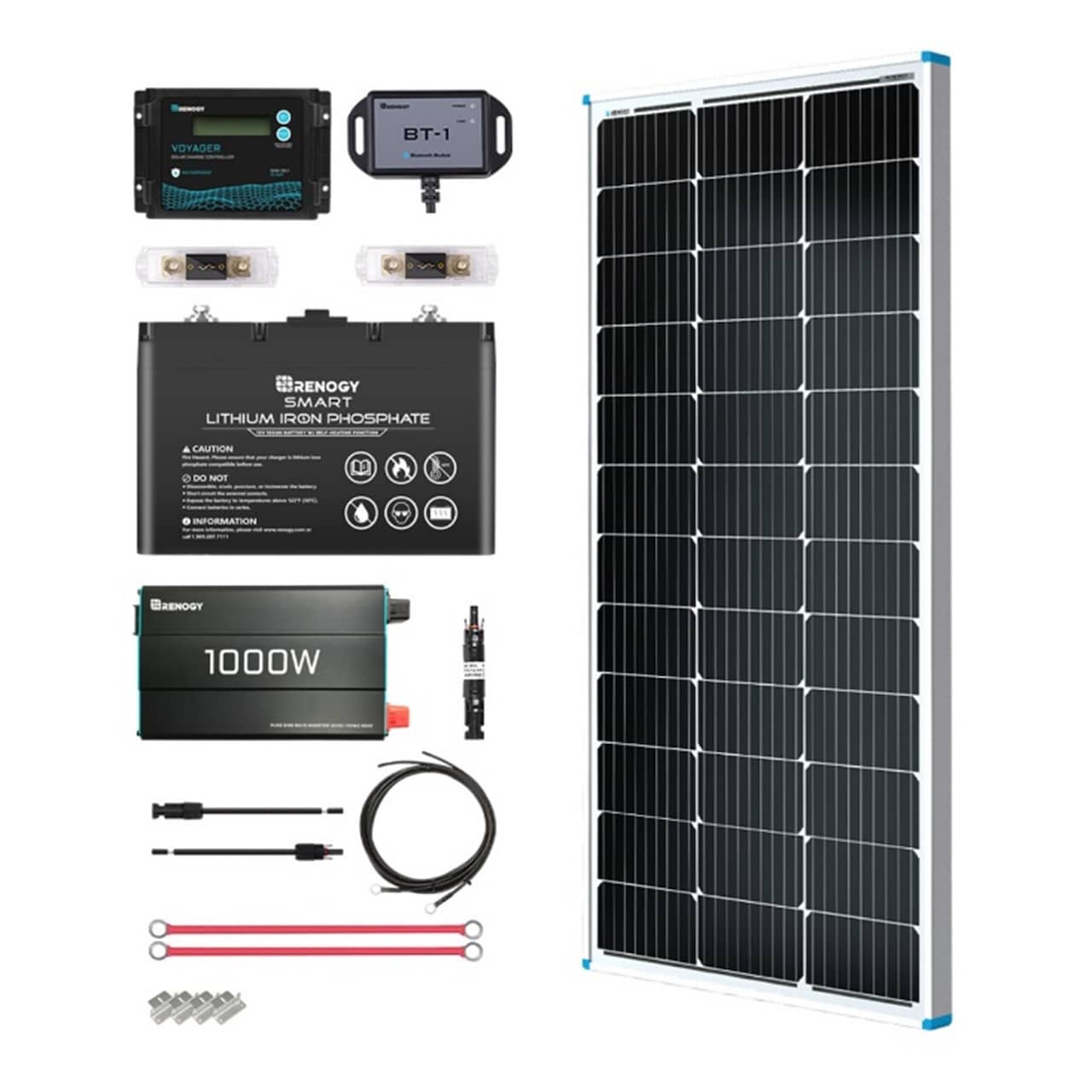
Renogy 100W 12V General Off-Grid Solar Kit. Renogy photo.
GoPower! is another excellent brand offering solar panels specializing in flexible panels. Their aerodynamic, durable, and lightweight panels feature a low profile while ensuring high efficiency through monocrystalline cells. These panels easily conform to almost any surface without compromising power output.
All GoPower! panels feature an impermeable lamination coat, facilitating and flexing against curved surfaces without requiring custom mounts. The installation options include adhesion or screws, both claimed to be straightforward and secure.
Each panel has a five-year warranty and is reasonably priced, making them a top choice. However, other options might be preferred if you’re not looking for flexible panels. Additionally, their warranty is shorter than brands like Renogy, and there is a lack of online information regarding potential panel issues. GoPower! Official Website
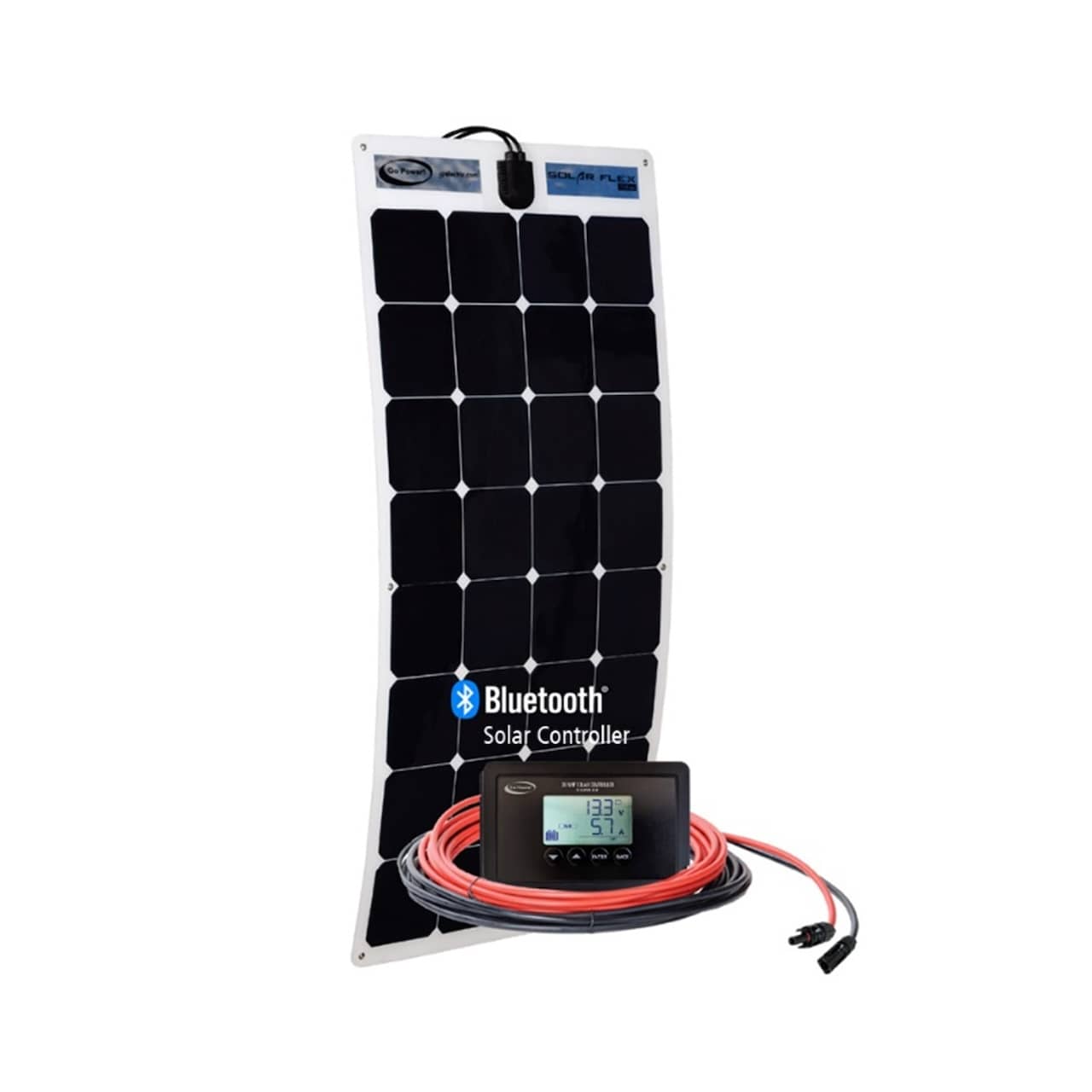
110 Watt Go-Power Flexible Solar Kit. GoPower! photo.
Best Budget-Friendly Marine Solar Panels
NewPowa offers monocrystalline solar panels, ideal for off-grid boating. These panels feature heavy-duty anodized frames with pre-drilled holes for mounting and a durable TPT back sheet that dissipates heat, ensuring better performance and lifespan.
NewPowa guarantees at least 80 percent maximum output within 25 years because of its high transparency due to low-iron tempered glass. Available in various dimensions and wattages, their panels cater to different needs and budgets, offering rigid and flexible options!
While NewPowa panels are among the most affordable options on the market, they are also less efficient. However, they suit small to medium-sized systems well, maximizing budget and efficiency. Some reviews suggest issues with their customer service, so consider this aspect when making your choice. NewPowa Official Website
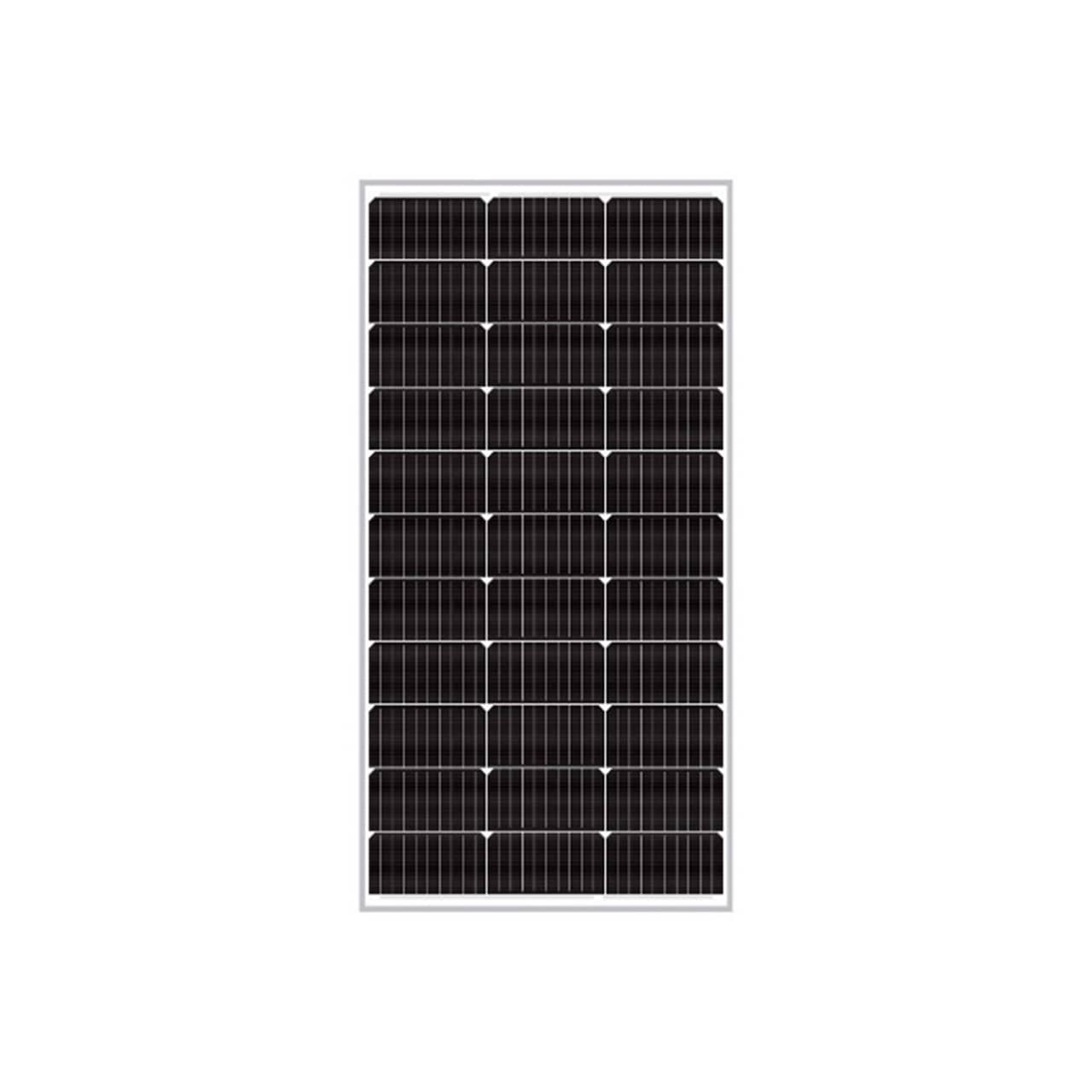
100W Monocrystalline 12V Newpowa Solar Panel. Newpowa photo.
After 15 years of development, Eco-Worthy has become a leading provider of independent off-grid solar solutions. Rated highly for their highly efficient, budget-friendly panels, Eco-Worthy panels feature vermiculite tempered glass and an aluminum frame, ensuring durability and protection against water and saltwater corrosion.
These panels guarantee to deliver over 80 percent of their initial power after up to 25 years of use, withstanding high wind and snow loads. Easy installation using the pre-drill hole method adds to their appeal.
However, Eco-Worthy panels lack flexibility like Solbian panels, challenging placement on curved surfaces. Marketed primarily toward sailboats and yachts, Eco-Worthy panels may not suit other types of vessels. If these limitations present no obstacle for you, their durability and reasonable pricing ensure a good return on investment. Eco-Worthy’s Official Website
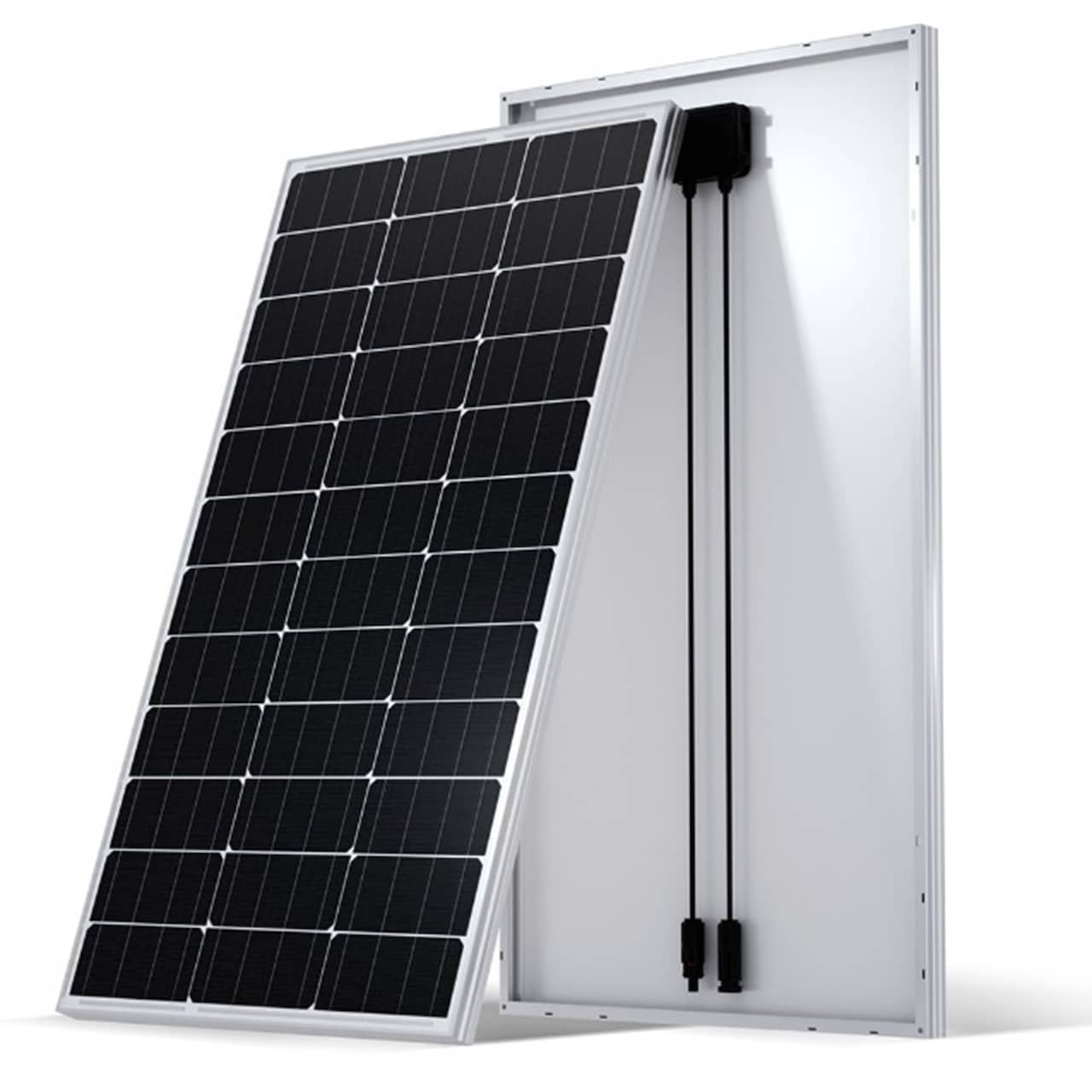
100W 12V Monocrystalline Eco-Worthy Solar Panel. Eco-Worthy photo.
Best Backup Solar Panels
For those seeking backup solar panels for emergency use, HQST offers a suitable solution. Ideal for powering lighting and navigation systems during outages, HQST provides portable solar panels that require no permanent installation.
These durable and efficient panels boast improved wiring design, ensuring at least 50 percent power production even when shaded; connecting them to a rechargeable portable power station or using the built-in USB ports to charge mobile devices is straightforward.
Their lack of permanent installation does mean setting up and dismantling after each use. Despite being less efficient than other panels and not as durable as premium options, HQST panels serve well in emergencies. HQST Official Website
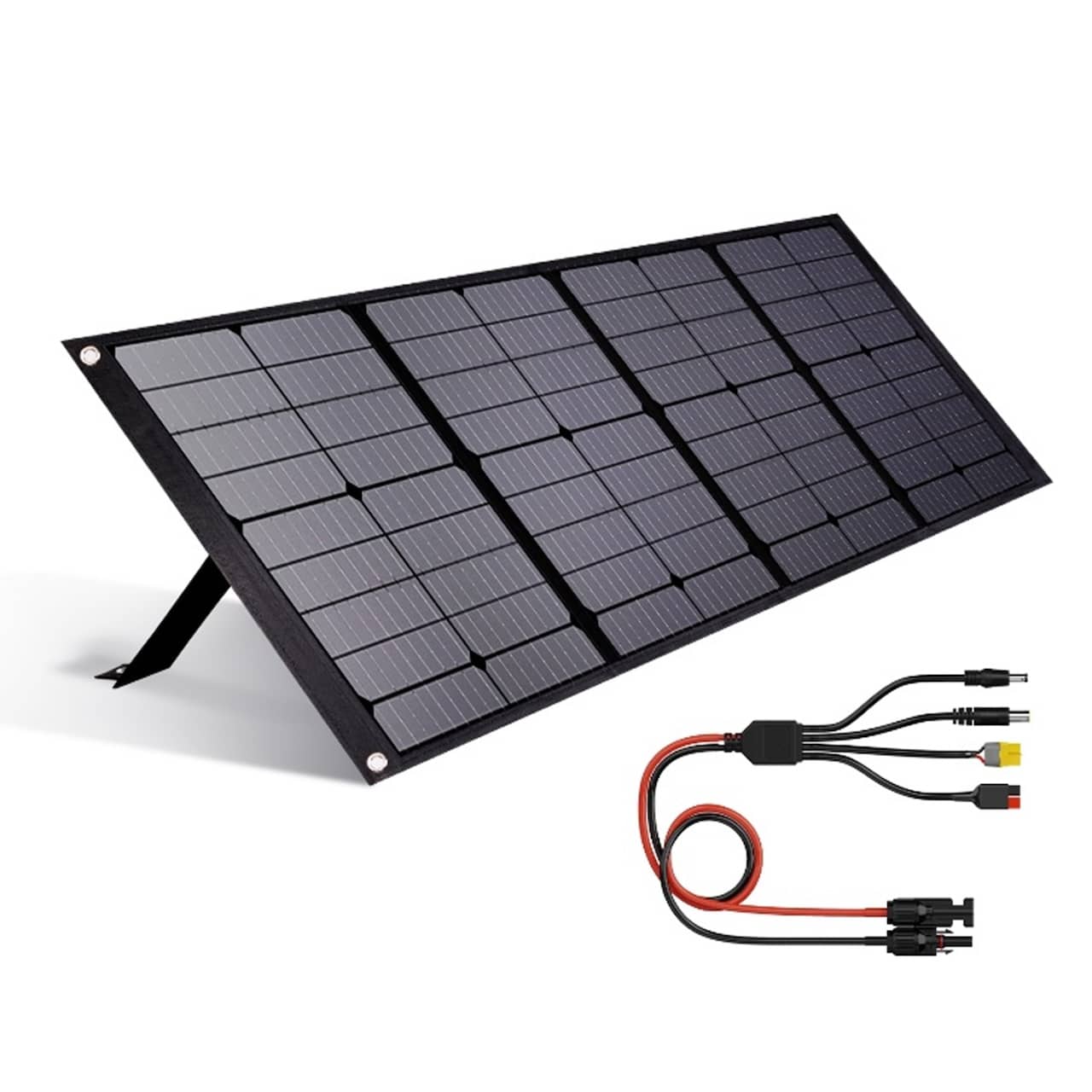
100 Watt 9BB Portable HQST Solar Panel. HQST photo.
Lensun Solar
Lensun Solar presents various foldable options suitable for emergency equipment. Their foldable solar panels, equipped with adapters compatible with most solar power station generators, feature high-quality A-grade PERC 9BB monocrystalline solar cells.
Lightweight, flexible, and boasting a higher efficiency of 23.5 percent, these panels are waterproof and capable of withstanding extreme temperatures. The kickstand design enhances solar energy absorption, making setup, carrying, and storage easy.
While they lack permanent installation like HQST, Lensun Solar’s portable panels serve well for charging phones and devices during emergencies or short trips. However, reviews suggest their flexible panels have a limited lifespan and may not last forever on a highly curved surfaces like a Bimini. Lensun Solar Official Website
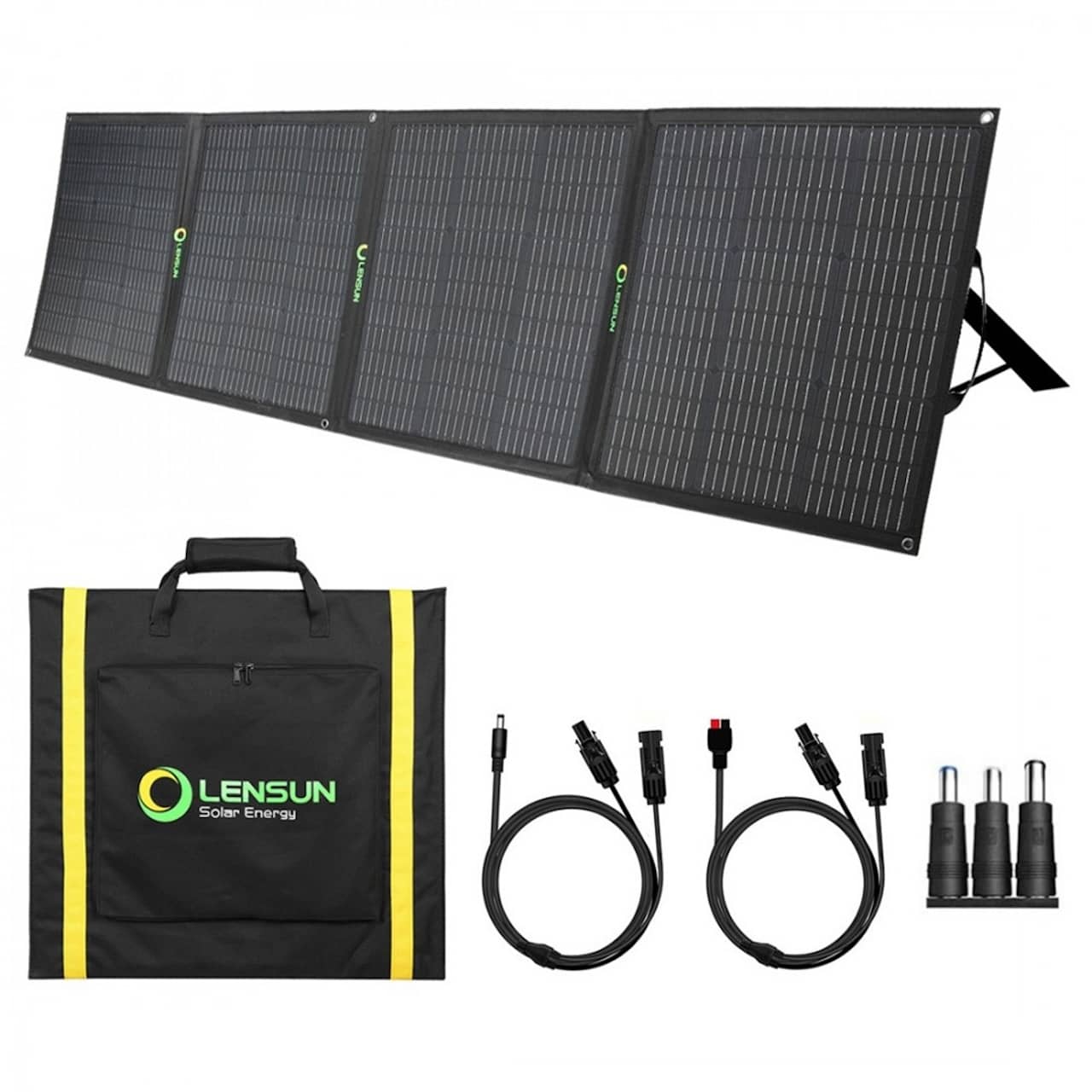
Lensun 200W 12V Foldable Lensun Solar Panel for GoalZero. Lensun Solar photo.
8 Points to Consider Before Buying Marine Solar Panels
Purchasing a solar system for your boat requires research and planning, considering power needs, budget, and configuration. While learning may take time, the information is readily available. Here are key considerations before buying solar panels from the mentioned brands or any other brand:
Power output
Begin by identifying the amount of energy needed. Create a list of every electrical system, appliance, or other device you want to power using solar energy, such as your cooler fridge, phone, kindle, etc. Calculate the energy requirement for each device by converting the current into amperes and multiplying it by the daily usage time.
Add up these ampere-hour totals for all electronics to get the total energy consumption in ampere-hours. Estimate the average sunlight hours per day in your vessel’s location. Then divide the daily energy consumption (in ampere-hours) by the average sunlight hours to determine the daily energy requirements in watts.
Space available for installation
Boats come in various sizes and shapes, requiring measurement of available dimensions and locations for panel placement. Considerations for proper fit, secure attachment, sun exposure, and aesthetic appeal should guide your selection.
Calculate the number of panels needed by dividing the required solar panel capacity by the individual panel wattage, ensuring it doesn’t exceed the allocated dimensions and weight limit.
Durability and waterproof rating
Before purchasing, ensure the panels are waterproof with an Ingress Protection (IP) rating of IP67 or higher. This safeguards the panels from water and dust: protective encapsulation layers and materials like ethylene vinyl acetate or tetrafluoroethylene shield solar cells and electronics from moisture. Verify proper sealing mechanisms for mounting equipment to prevent water ingress.
Establish a budget for solar panels, considering the balance between cost and quality. Cheaper panels may save money initially but could compromise long-term efficiency and durability. Compare prices, system components, warranties, and services offered. Consider the return on investment, evaluating potential savings on batteries or shore power over time.
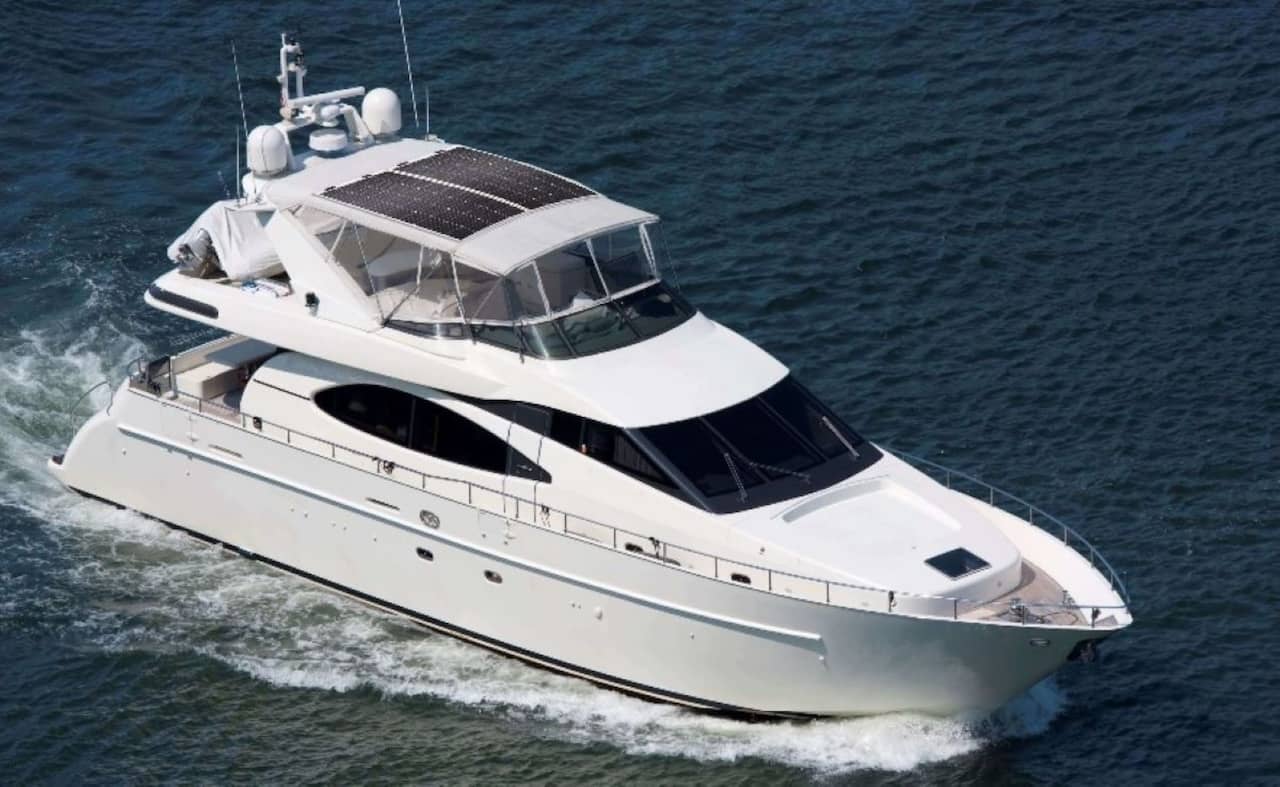
Renogy 350 Watt Solar Flexible Kit on flybridge Bimini. Renogy photo.
Brand reputation
Check for good brand ratings and customer satisfaction as indicators of a reliable purchase. Ensure satisfaction with the warranty, recognizing that while durable, solar panels are not invincible.
Type of solar panel
Select a panel type based on location needs. Rigid panels are durable and efficient but heavier, while flexible and semi-flexible options offer versatility. Portable panels are easy and ideal for small electronic devices.
Accessories
Consider additional accessories like charge controllers, inverters, mounting brackets, hardware, and batteries. Some brands may require specific accessories. Solar kits can simplify the process.
Installation
Decide on the installation approach based on your system size. Hiring an installer may save time, while a DIY approach can save money but requires more research and execution time.
Solar can be a valuable addition to most boats. While it requires research and investment, the long-term benefits, including enhanced life at sea, often make it worthwhile. We look forward to witnessing advancements in the solar energy industry. Your solar journey is an exciting endeavor that, with careful consideration, can significantly improve your boating experience.
Written By: Denelle Balach
Denelle Balach is a lifelong boat enthusiast who has spent her days at Lake Erie on kayaks, speedboats, and anything in between. She channels her passion for boating and writing into concise, engaging content for boating and yachting publications and maritime agencies. She can be reached through her website: www.denelle-balach.com .
More from: Denelle Balach
Related Articles and Guides
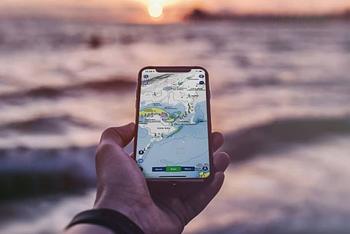
30th Mar 2024
Best Boat Navigation Apps for Smartphones
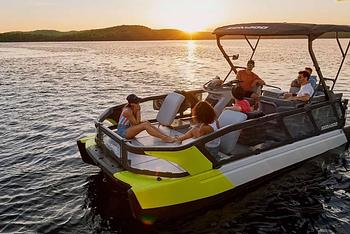
29th Mar 2024
Best Jet Boat Brands Among All Types of Small Craft

26th Mar 2024
Best Sport Fishing Boats, Convertible and Express to Center Console
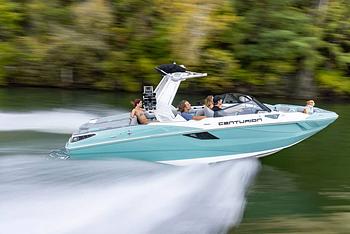
20th Mar 2024
Best Wakesurf Boat Brands, V-Drive, Jet-Drive, Forward-Drive & More
- Explore Rightboat
- Boats for Sale
- Boating Articles
- Buyers Guide
- About RightBoat
- Sell Your Boat
- Boat Selling Advice
Enter your email to keep up to date with the latest news
Join for free
Sign up now for free and discover how easy it is to keep up to date with THE latest boats for sale. Find your right boat, and tailor your voyage to finding your next boat.
Benefits of becoming a member:
- Set up tailored alerts
- Personalise your experience
- Download full specifications and broker details
- Keep tabs on your favourite boats
Are you a broker? Join as a Broker
Rightboat - join for free.
Do you have an account already? Login
Save this search
Save your search and receive new boats in your email..
You can unsubscribe from your alerts whenever you like. By pressing the button you accept the Legal Terms and conditions
- Solar accessories
- Solar panels for boats: What..
Solar panels for boats: What you need to know
- Share to LinkedIn
- Share to Facebook
- Kerry Thoubboron
As subject matter experts, we provide only objective information. We design every article to provide you with deeply-researched, factual, useful information so that you can make informed home electrification and financial decisions. We have:
Sourced the majority of our data from hundreds of thousands of quotes through our own marketplace.
Incorporated third-party data and information from primary sources, government agencies, educational institutions, peer-reviewed research, or well-researched nonprofit organizations.
Built our own database and rating system for solar equipment, including solar panels, inverters, and batteries.
We won't charge you anything to get quotes through our marketplace. Instead, installers and other service providers pay us a small fee to participate after we vet them for reliability and suitability. To learn more, read about how we make money and our Editorial Guidelines .
)
Owning a boat can be expensive; you have to pay an upfront cost to purchase it, and you'll also have to spend money on maintenance and fuel charges. Solar panels may be the answer if you're looking for a reliable, cost-effective way to power your boat.
- 100% free to use, 100% online
- Access the lowest prices from installers near you
- Unbiased Energy Advisors ready to help
How do solar panels work on boats?
Solar energy systems on boats work similarly to other portable , off-grid systems. There are four important components to a marine solar panel system:
Solar panels
Charge controller
Most marine solar panel systems require charge controllers to prevent the batteries from receiving more voltage than they can handle. Without charge controllers, you risk overcharging and damaging your battery.
Depending on your boat's electrical setup and the appliances you need to power, you may also need an inverter to convert direct current (DC) electricity into alternating current (AC) electricity. Some boat electronics use DC and don't need an inverter. However, if you use everyday household appliances on your boat (i.e., TVs, microwaves, or hairdryers), they likely run on AC electricity, and you'll need an inverter.
You can buy all of these components separately, but you can find solar panel kits that include some or all of the necessary parts. Some marine solar panel kits include the wires, cables, and mounting equipment required to get your boat's solar panel system up and running.
Best solar panel kits for boats
Below are a few products tailored to off-grid marine solar power systems.
Boat solar panel options
If your solar panel kit does not include an inverter or charge controller, you must buy those components separately. Battery storage products occasionally have built-in inverters and/or charge controllers.
Should you install solar panels on your boat?
There are numerous benefits to powering your boat with solar energy. One of the most attractive benefits of marine solar power systems is the monetary savings. You'll need to invest money upfront to purchase solar equipment; however, once it's up and running, you'll generate free electricity for your boat. Alternatives to electrifying your boat, like gasoline-powered generators, require purchasing fuel on an ongoing basis. Switching to solar power can reduce these purchases while protecting you against rising fuel costs.
Another benefit of marine solar panel systems is the quietness of operation. Running a generator can be a noisy disturbance for those going out on the open water to experience nature. Powering your boat with solar allows you to enjoy peace and quiet without losing power.
Furthermore, you can also safely generate electricity and charge your battery with solar power while you're away from your boat. This isn't feasible with generators - running a generator requires manual operation and monitoring. With solar panels, you can produce usable electricity during the day and then use it for weekend boating adventures.
However, there can be obstacles to installing solar on a boat, perhaps the largest of which is available space. Ideally, your solar panels can be installed in an area with uninterrupted sunshine. Depending on your boat type, this space may be easy or difficult to come by. While you likely get a lot of sun out on the water, the area may be too small or have too many obstacles that make fitting the number of solar panels necessary to generate your electricity needs difficult.
Consider your boat's deck or canvas when you're looking for spots to install a marine solar panel system. Remember that the positioning of your solar panels will also impact the type of equipment you should purchase – you may be able to use traditional monocrystalline and polycrystalline solar panels if you're installing on a fixed, rigid section of your boat. However, if your only open space available isn't suitable for fixed mounting, installing lower-efficiency flexible solar panels may be a better option. Some flexible solar options have an adhesive backing, so you won't need to worry about the constraints of traditional mounting and racking materials.
How many solar panels do you need for your boat?
Unsurprisingly, a yacht has very different power requirements than a sailboat. The number of solar panels you'll need for your boat not only depends on the type and size of your boat, but also the quality of the equipment you choose, how many sun-hours the boat sees, and the amount of electricity you require. Some boats can get by with one 100-watt solar panel (or even smaller), while others need a multi-panel setup.
Calculating your electricity load is the first step in determining how many solar panels you need. Below are some common appliances you may use on your boat and what they draw for power.
How many solar panels do you need for common appliances?
The last column of the above table is the amount of energy you'll consume in watt-hours running each appliance for the number of hours identified in column three. One 100-watt solar panel that receives direct sunlight for 5 hours will produce approximately 500 Wh of electricity (5 hours x 100 W = 500 Wh). Not considering conversion losses, that's enough electricity to power a mini-fridge for 24 hours or power a boat's GPS display for 10 hours. Running all of the appliances above for everyday use will require multiple 100-watt solar panels or fewer higher-wattage panels.
Install solar to save on electric bills
You can save money by installing a marine solar panel system, but you'll save even more by installing solar on your home or business. If you want to evaluate your solar options, check out the EnergySage Solar Marketplace . You can receive up to seven custom solar quotes from local installers to compare. You can also try our solar calculator for a quick estimate of solar costs and savings on your property.
Create your own clean energy with solar panels.
Enjoy the benefits of solar without rooftop panels.
Explore heat pumps, the latest in clean heating & cooling technology.
See solar prices near you.
Enter your zip code to find out what typical solar installations cost in your neighborhood.
- Our offerings
- Community solar
- Heating & cooling
- Backup power
- EV charging
- For your business
- Other energy options
- Solar calculator
- Solar rebates
- Help center
- Home solar guide
- Market intel
- Refer a friend
- Mission & values
- How it works
- Editorial guidelines
- Work with us
- Solar & HVAC installers
- Corporate partnerships
- Community programs
- Utility programs
ENERGYSAGE is a registered trademark and the EnergySage logo is a trademark of EnergySage, Inc. Other trademarks are the property of either EnergySage, Inc. or our licensors and are used with permission.
© Copyright 2009-2024 EnergySage, Inc. All rights reserved.
Learn more about our success working with the U.S. Department of Energy.
- svg]:stroke-primary"> 735K
- svg]:stroke-primary"> 133K
- svg]:stroke-primary"> 54.1K
The Best Portable Solar Panels of 2024, Tested and Reviewed
By Laura Lancaster
Updated on Mar 26, 2024 1:32 PM EDT
17 minute read
Bluetti PV120
Jackery solarsaga 200w, zendure 400w.
We may earn revenue from the products available on this page and participate in affiliate programs. Learn More ›
The sun powers our world, and with the right portable solar panel, it can also power your outdoor adventures or home emergency set up. I’ve tested dozens of models from top brands like Bluetti, Jackery, Anker, Goal Zero, EcoFlow, and BioLite, and have come away impressed with their power generation potential. To help you decide which of the best portable solar panels is right for you, I tested 14 options running from 100W to 400W for power potential, ease of use, and portability.
Topics and Products Covered
- Jump to Review
- Rest of the Field
- Full Specs and Test Results
Things to Consider Before Buying a Portable Solar Panel
If you’re looking to purchase both a power station and portable solar panel, check out my take on the best solar generators ; It looks at which pairings provide the best bang for your buck.
How I Tested the Best Portable Solar Panels
My solar panel testing consisted of three criteria: performance (measured power output), portability, and ease of use. I also considered other factors like price, warranty, and IP rating (a third-party test that looks at dustproofness and waterproofness). I focused this review on the solar panels between 100W and 400W and tested panels from Jackery, Bluetti, EcoFlow, Anker, Goal Zero, Dakota Lithium, Vtoman, Zendure, Ugreen, BioLite, and Lion Energy.
Testing Power Generation
Performance was tested twice: on a clear day and on a cloudy day. I used the best portable power stations to measure the solar energy generated by each panel and used the Anker SOLIX 100W panel as my control panel to account for inconsistent conditions between tests. I used the attached sundial on the Anker SOLIX 100W to ensure the panels were always optimally oriented toward the sun. Then I took a reading from each panel, adjusting the results as necessary based on the reading of the control panel.
Testing the Portable Solar Panels’ Ease of Use
Ease of use was assessed by looking at how easy or difficult it was to set up each panel. Some portable solar panels had adjustable legs or sundials that made them quick and easy to use —- these were ranked as Excellent. Others toppled over easily, refused to lie flat, or had complicated setups. Those were rated Poor.
Testing Portability
How portable a solar panel is depends in large part on its physical size. 400W solar panels are a lot harder to lug around than 100W solar panels, and they won’t fit as easily in your car or on a garage shelf. Even given that, I was surprised at how much variability there is in features such as handles, cable storage, and latching mechanisms. I moved each solar panel up and down multiple flights of stairs and out to my testing site over several days, giving me ample insight into how portable each unit is.
While the above criteria is how I graded each of the best portable solar panels, there is one more factor that should inform your choice: compatibility with your portable power station . There are two things you need to check: load compatibility and port compatibility. For load compatibility, check that both the volts and the wattage supplied by the solar panel won’t overload your power station. I’ve listed the specs for each solar panel in this test, and you can typically find the information for your power station in very small font on the bottom of the unit.
For port compatibility, you simply want to look at whether the cord coming out of the solar panel can be connected to the power station you are purchasing. Unfortunately, different brands use different cords, and some brands even use different cords within their lineup, which is all very frustrating. In some instances, you may be able to purchase an adapter cord if the provided cable for the solar panel doesn’t match the ports on your power station. Goal Zero has a number of cables to convert mismatched ports and plugs that can help get you started.
Best Portable Solar Panels: Reviews & Recommendations.
- Best 100W: Bluetti PV120
Report Card
- Full Sun: 110W (92% of claimed 120W potential)
- Clouds: 25W (21% of claimed 120W potential)
- Portability: Excellent
- Ease of Use: Great
Key Features
- Weight: 13 pounds
- Packed Size: 21 x 19 inches
- Output Ports: DC
- Rated Voltage: 20V
- IP Rating: IP 65
- Lowest Operating Temp: 14 F
- Warranty: 1 year
- Best power generation of all the portable power stations at its price point
- Packs up securely
- Comfortable to carry
- No sundial feature
The Bluetti PV120 bills itself as 120 watt capable, but it’s about the same size and, more importantly, price of all the other 100-watt panels, so we’re grouping it here. And in its size category, the Bluetti PV120 is far and away the best performer, producing well over 100 watts in full sun while beating out the competition in shady conditions. It’s exceptionally portable, with a comfortable handle, an accordion shape that clips together so it won’t come apart while you’re walking. I also appreciate the handy storage bag for its cable, so that you don’t misplace it when not in use. Trust me, I misplaced plenty of charging cables while testing the best portable solar panels and being able to pack away the charging cable with the solar panel itself is very helpful.
The smaller sized solar panels are all easier to set up than the larger 200W and 400W models, but even within these, the Bluetti PV120 stood out as being easy to use. It has the right number of kickstand legs in the right places, and you can securely adjust the angle using snap buttons on the back of the legs.
- Best Value 100W: Anker SOLIX 100W
- Full Sun: 94W (94% of claimed 100W potential)
- Clouds: 22W (22% of claimed 100W potential)
- Ease of Use: Excellent
- Weight: 11 pounds
- Output Ports: XT-60
- Rated Voltage: 27V
- IP Rating: N/A
- Lowest Operating Temp: -4 F
- Warranty: 2 years
- Strong performance in sun and clouds
- Sundial feature!
- Not as easy to adjust as the Bluetti PV120
The Anker SOLIX 100W (formerly the 625 model) has been my control panel for every round of testing I’ve done over the last two years of the best portable solar panels. The reason for that is the sundial feature. It is hard to overstate what a useful feature this is. Whereas with other panels you’re left guessing if you’ve got it angled correctly toward the sun, which leaves you adjusting it while you watch the wattage meter on your portable power station go up or down.
With the Anker SOLIX 100W it’s easy to see which direction you need to tilt the panel to ensure the dot shadow is inside the bull’s eye. This makes a surprisingly big difference — even with the 100W panels we’re talking a 10W or more difference in power generation for minor adjustments. I do not understand why other solar panels don’t have this feature (the only others I’ve tested that have it are the BioLite 100W and the Ugreen 200W).
Unfortunately for the Anker SOLIX 100W, it’s not as easy to adjust the kickstand legs as the Bluetti PV120, and it didn’t have quite the same power potential (although still beating out the others in the 100W range). But for the built-in sundial feature alone it’s more than worth your money.
- Best 200W: Jackery SolarSaga 200W
- Full Sun: 184 (92% of claimed 200W potential)
- Clouds: 49 (25% of claimed 200W potential)
- Portability: Great
- Weight: 14 pounds
- Packed Size: 24 x 21 inches
- IP Rating: IP 68
- Warranty: 3 years
- Best performance in the cloudy weather test, second best performance in sunny weather
- Lightweight
- Good warranty
- No sundial feature
If money is no object then you would be hard pressed to do better than the Jackery SolarSaga 200W. I’ve been consistently impressed by the performance of this panel in all manner of conditions, from sun to clouds — I’ve even seen it generate power in total shade with dusk approaching. It’s plenty easy to set up; It’s plenty easy to transport. It’s the total package. It would be nice if the kickstand legs could be adjusted more securely, like with the Bluetti and Anker 200W solar panels, but it’s never been an issue for me in practice given the wide design and springiness of the elastic holding the legs in place. The only real catch is the price, which is hundreds of dollars more than my best value pick. Try to find this one on sale if at all possible.
- Best Value 200W: Bluetti PV200
- Full Sun: 178W (89% of claimed 200W potential)
- Clouds: 44 (22% of claimed 200W potential)
- Weight: 19 pounds
- Packed Size: 25 x 23 inches
- Output Ports: MC4
- Rated Voltage: 21V
- Adjustable legs are easy to use
- Excellent power generation in both sun and clouds
- MC4 connector is easier to mix and match than others
- Shorter warranty than others on this list
This solar panel is an excellent value. You get pretty darn close to the power generation potential of the Jackery SolarSaga 200W — in both sun and clouds — and you pay about a third less. I particularly like its setup, including the snap buttons on the kickstand legs that you can use to adjust the angle of the panel. The carrying case design is also top notch, with a comfortable handle and zippered pouch for its cable. The snaps that hold the panels in place when folded up are also a nice tough.
I don’t love the warranty on this — one year is awfully short or a product that realistically should last a decade or more. But that’s my only gripe. After a year of using and abusing the 120W version of this panel, I haven’t run into any durability issues with this series yet.
- Best 400W: Zendure 400W
- Full Sun: 359W (90% of claimed 400W potential)
- Portability: Good
- Weight: 30 pounds
- Packed Size: 39 x 22 inches
- Output Ports: XT-90
- Rated Voltage: 40V
- IP Rating: IP 54
- Largest power potential in my test
- Lighter than other 400W panels I looked at
- Not compatible with standard portable power stations
Watt for watt, the Zendure 400W solar panel has exceptionally good performance. In ideal weather conditions, I’ve seen it generate over 400 watts of power at a time. It’s also surprisingly lightweight, easy to transport, and, for a larger solar panel, wasn’t particularly onerous to set up. I did not, however, keep it in my arsenal after my initial test (in conjunction with my appraisal of the Zendure SuperBase) due to its large size and lack of compatibility, and thus was unable to perform a test in cloudy weather conditions.
The Zendure 400W comes with an XT-90 cable. That means it’s not compatible with any power station in my test of the best portable power stations; in fact, the only power station I’ve ever tested that it is compatible with is the Zendure SuperBase, a power station that was not what I would call “portable,” given that it weighed nearly as much as I do. While the stated voltage output of the Zendure 400W is such that it should be possible to convert it to a different connector style (like an XT-60) with an adaptor, I have not tested this so cannot speak to whether a loss in amps would affect the power output potential.
The other catch to the Zendure 400W is that it’s pricey, a whopping $500 more than my best value pick.
- Best Value 400W: Anker SOLIX 400W
- Full Sun: 330W (83% of claimed 400W potential)
- Clouds: 77W (19% of claimed 400W potential)
- Portability: Fair
- Ease of Use: Good
- Weight: 35 pounds
- Packed Size: 39 x 26 inches
- Rated Voltage: 48V
- IP Rating: IP 67
- Lowest Operating Temp: -4F
- Lowest price of all the 400W panels I looked at
- Comparatively easy set up
- Less power output than expected in cloudy weather
- Uncomfortable handle and no pocket for cable storage
This one was closer than I was expecting. The Vtoman 400W solar panel, despite being heavier, was easier to transport due to its better handle design and the zip pocket for the cable. It also had a better performance in cloudy weather than the Anker SOLIX 400W.
A look at the adjustable kickstand legs of the Anker SOLIX 400W
But the Anker SOLIX 400W had a strong showing in full sun, was a couple hundred dollars less expensive, and was miles easier to set up. The Vtoman 400W has floppy kickstand legs that are difficult to get into position. The Anker SOLIX 400W has adjustable legs that made it fairly simple to get what would otherwise be an unwieldy panel set to the right angle for optimal power generation. Given how important it is to adjust the angle of your solar panel regularly to maximize power potential, this is an important detail that puts the Anker SOLIX in the top spot for value.
The Rest of the Field
While the Vtoman 400W solar panel had one of the worst setups of any portable solar panel I tested (giant panel plus floppy legs is a bad combo), it did come with my all-time favorite cable. This one can be paired, out of the box, with the widest array of power stations. While there is some danger with mixing and matching solar panels and power stations (Goal Zero has told me that they discourage it with their products), for individuals confident that they can assess the power potential and capabilities of various power stations, this could be an interesting choice.
While I’m a big fan of EcoFlow’s portable power stations (their Delta 2 was my best overall pick in that test ), I find their solar panels unnecessarily fussy. First off, they don’t have kickstands. Instead you’re meant to attach the panel to the four corners of the carrying case, and then adjust the angle by zipping or unzipping the case. This more or less works, but is ridiculously fiddly.
Second, this panel, when stored for long periods of time, can start to warp such that I have found it difficult to fully flatten out. As a result, I think you’re better off skipping these units, despite their impressive power potential. The only exception to this is if you are specifically looking for a panel that can generate power on both sides — in my testing, it typically can produce half the volume of power on the opposite side, which is an interesting feature.
I similarly find there to be a pretty major discrepancy between my experience of Goal Zero’s portable power stations and their portable solar panels. Their Boulder series, while somewhat more affordable, is heavy and clunky for the amount of power it produces and you can’t adjust the angle to match the sun. I was optimistic that the more lightweight Nomad 200W would improve on the experience but I was, unfortunately, unable to complete testing due to the incompatibility of its charging cables with the Goal Zero unit I have on hand.
While the cloudy weather testing result was quite impressive, the sun has disappeared from these PNW skies for the foreseeable future (I will update this review with the results of the blue sky testing at a later date). Also frustrating was the lack of a carrying handle on the case, a detail that made it surprisingly awkward to carry. When I queried Goal Zero, they reported that their solar panels will operate down to -40° F, far and away the lowest claimed temperature in my test.
The Dakota Lithium 180 got surprisingly high marks for portability but was ultimately not powerful enough compared to other panels at that price point and lower. It also eschewed kickstands in favor of tie-off loops which was fine, but I would have preferred the kickstands to achieve maximum solar input. But the unique accordion shape of the panel made it, by far, the most portable solar panel in my test.
A few panels that impressed on portability and ease of use but failed to deliver the power others were capable of included the BioLite 100W, and the Ugreen 100W. The Lion Energy did impress during testing (it also stood out as one of the few solar panels that didn’t look like it had been produced in a mono manufacturing facility), but didn’t quite make the cut for one of the above awards.
Full Specs and Test Results for the Best Portable Solar Panels
100w solar panel specs, 100w solar panel performance, 200w solar panel specs, 200w solar panel performance, 400w solar panel specs, 400w solar panel performance, power station compatibility.
All of the portable solar panels in this test must be paired with one of the best portable power stations . While there are some solar chargers that include ports for a classic USB-A or USB-C cable, the ones in this test are producing so much power that this is not an effective way to capture it — if they went full throttle at your phone they would fry it. So you need an intermediary to hold the power and release it in a controlled way.
Laura Lancaster
There are two specs to check for when looking to see if your portable solar panel is compatible with your portable power station: power potential and connector/port compatibility.
Power Potential Compatibility
Solar panels aren’t all that smart. Whatever blast of sun they are getting will be transmitted directly as power to your power station. So before you purchase a portable solar panel, first look at your power station to see how much solar input it can handle. (This is typically found in very small font on the bottom of your power station). Don’t purchase a solar panel or solar panels that exceeds this power potential, as it can damage the battery in your power station.
Solar Panel Connector and Power Station Port Compatibility
In the same way that you can’t plug a USB-C charging cord into a lightning port, not all solar panel cable connectors are compatible with every power station port. The most common ones I’ve seen while testing are 8mm DC, XT60, HPP (High Power Port). While you can in some cases find an adaptor cord so that you can use a solar panel with an 8mm charging cable with a power station with an XT60 port, this is a bit of pain.
Power Potential
Once you’ve locked in on which portable solar panels are compatible with your current power station, the next major question to ask is how much power you want to generate. Generally, larger solar panels generate more power than smaller solar panels, but are unwieldy to transport and set up. The above tables drill down more on which solar panels in testing produced the most power in full sun.
Portability and Ease of Set Up
While several of the solar panels I tested seemed to be made in the same manufacturing plant — same colors and fabrics, similar design choices — there was still some surprising variability in ease of set up and portability. Generally, the largest solar panels were the most difficult to move and set up, and the smaller ones the easiest, but details like handle comfort and number of kickstands made a surprising difference in the overall experience.
It’s a lot of fun to own a portable solar panel. Charging up your phone or your laptop with nothing more than the power of the sun is pretty satisfying, and it can give you some peace of mind in the event of a power outage. For some people, it can supplement one of the best portable power stations as part of their at-home emergency kits. For others, it can extend the length of time they are able to be off-grid with an overlanding setup. Typically, though, whether or not a portable solar panel is worth it depends in large part on how much sun the area you are in gets.
I was impressed to see that the best portable solar panels really do produce the amount of power they say they do. If you live in a sunny part of the country, you can be confident that the wattage stated on the solar panel is more or less the wattage that you will get — assuming you get the panel oriented for optimal efficiency. I recommend purchasing a sundial to clip onto your solar panel so that you can be sure it’s angled directly at the sun.
The size solar panel you need depends on a few factors, including how much energy your power station can accept from a solar panel, how much power you are hoping to generate, and how important portability is to you.
Final Thoughts
The best portable solar panels on this list are all excellent choices for pairing with the best portable power stations. If you do decide to mix and match brands and models, double check that the cable requirements and voltage capabilities match up first.
When you use links on our website, we may earn a fee.
Best Solar Panels For Your Home of 2024
Solar panels can power your home entirely or supplement what you receive from your regional power grid. While purchasing solar panels requires an upfront investment, they can save you money in the long run and tap into a renewable power source that has little to no impact on the environment.
Many solar panels are on the market today, with important differences among them. To determine the most suitable system, consider what you want and need: a low-cost system, the most efficient panels, a powerhouse system for a business, or one that can withstand high wind, heavy rain or snow, or extreme temperatures. Whatever your needs, you'll likely find a system to fit them in our list of the best solar panels.
Table of Contents
- Best Solar Panels
- Things To Consider When Buying
- How We Chose
Aiko N-Type ABC White Hole (72 Cells) »

Has a high efficiency of 24%
Offers robust power output of 620 watts
Has a simple but elegant design
Must request price information
Offers shorter product warranty among competitors
While a variety of factors are at play when determining the best overall solar panel, ultimately the production of power is the most important factor of all. When it comes to raw numbers, few panels can compete with the Aiko N-Type ABC White Hole. Its 24% efficiency is higher than the average, which hovers around 20%, and at 620 watts, its power output ranks among the best of available solar panels. While all solar panels become weaker over time as they degrade, this model still manages to retain close to 89% of its initial capacity after decades of use, or about 550 watts. In other words, in the year 2053, this solar panel will still perform better than many of the new panels you can buy today.
With a trifecta of power, efficiency, and longevity, the N-Type ABC White Hole is the best overall solar panel on our list. One small drawback is that the price of this panel is not listed publicly, which makes it difficult to estimate how expensive it would be in comparison to comparable models.
Canadian Solar HiHero »

Charges low average cost, between $16,000 and $20,000
Has solid efficiency of 22.8%
Offers good power output of 445 W
Provides power that may not be enough for larger homes
Offers warranty that’s below industry standard
Installing solar panels can be a fairly expensive process, with an average cost of around $25,000 for a home. As such, it's quite understandable that many customers are looking for a good deal on solar panels – and they may find it with the Canadian Solar HiHero series. With an average price range between $16,000 and $20,000, these panels are frequently less expensive than competitors’ options.
Despite the lower cost, the panels still have an impressive efficiency of nearly 23%, and their power output of 445 W isn't bad either. While this may not be enough wattage to power larger homes or commercial properties, it's a solid performance for a typical home.
One thing to note is that Canadian Solar's 15-year product warranty is on the shorter side among competitors. That said, the annual degradation of the HiHero model does match industry standards, so if you're willing to overlook the warranty, the price you'll pay is worth the performance you'll receive. And that's why we've picked this solar panel as our best budget option.
SunPower M-Series »

Offers average power output of 440 W
Degrades at a low rate
Comes with a 25-year warranty
Is more expensive than many competitors
Has significant upfront costs
With average project costs of around $24,000 to $29,000, SunPower's panels can be a bit more expensive than many competitors’ products. But you certainly get significant value for your money. SunPower's 0.25% annual degradation rate starting at year two is significantly lower than almost all competitors. This means your panels should continue to be powerful sources of energy for several decades after you purchase them. So, although the initial costs are steep, SunPower panels perform exceptionally well years after they're installed, and that could easily make the cost worth it.
At 440 W, the average power output is in the middle range of competitors, but SunPower panels have some other perks that might make the price worth it. For example, the panels use microinverters, which monitor the output of individual panels, whereas the more typical string inverters monitor the system as a whole. Because microinverters are tuned to specific panels, the whole system can operate more efficiently. We also like the comprehensive 25-year warranty, which covers both the product and its power output.
REC Alpha Pure-R »

Offers exceptionally low temperature coefficient
Has sturdy construction to protect against weather
Covers performance, product, and labor with warranty
Must use a REC-certified installer to be covered by warranty
Has a lower efficiency rate than some competitors’ panels
For those who live in warm-weather environments, the REC Alpha Pure-R solar panel is a great choice thanks to its extraordinarily low temperature coefficient. This means that Alpha Pure-R panels produce more power output than is typical when temperatures rise, unlike many other models that struggle to be as efficient in the heat. The panel's extra-sturdy construction also makes it capable of withstanding stormy weather conditions. We also like that the warranty covers not only the product and its performance, but also labor.
The one catch here is that the warranty only covers the product and labor as long as your panels were put in by a company-certified installer. We also should note that the 22.3% efficiency rate is a bit lower than most competitors, although the difference is relatively small and probably should only be a minor consideration.
Panasonic EverVolt HK Black Series »

Has a low rate of annual degradation
Provides up to 92% power output after 25 years
Covers performance, product, parts, and labor with warranty
Provides lower power output than many competitors
Outsources panel construction
These solar panels come with a low 0.25% rate of annual degradation, which is impressive, but this isn’t the only factor that helped crown the Panasonic EverVolt HK Black Series as the most durable solar panel on our list. The excellent 25-year warranty that covers the product, its performance, parts, and labor also helps ensure that these panels continue to work well for many decades. In fact, you can expect only an 8% decline in power output after 25 years. And if any damage should occur during that time, you can rest easy knowing it will likely be covered by your warranty.
One downside, however, is that the power output of 410 W is lower than most other models on our list. While still in the range of industry averages, 410 W doesn't make this panel a powerhouse. It's also worth mentioning that in 2021 Panasonic decided to stop manufacturing its panels at its own factories, although there doesn't seem to be any indication the quality has suffered as a result.
Qcells Q.Peak Duo Blk ML-G10+ »

Produces frame certified for heavy snow and wind
Offers all-weather technology for maximum efficiency in all conditions
Was the first manufacturer to pass a comprehensive quality test
Has relatively high rate of degradation
Offers lower efficiency rate than many competitors
Depending on where you live, you might worry about whether a particular solar panel can withstand extreme weather conditions, which could range from high winds to blizzards to intense rainfall. Qcells has designed a panel with these conditions in mind. Its Q.Peak Duo Blk ML-G10+ model has an aluminum alloy frame that can withstand high thresholds of snow and wind. The panel also comes with innovative all-weather technology that aims to achieve maximum power output regardless of weather.
That said, this is a panel probably best reserved for those focusing primarily on harsh weather conditions, since this model has both a lower power output and a significantly higher rate of degradation than many of its competitors. This means you can expect less performance in both the short and long term compared to the other products on our list. However, these other products are probably less equipped to handle whatever Mother Nature might throw at your house, so you should weigh the pros and cons for your own property.
JA Solar JAM72S30-550/MR/1500V »

Offers high power output of 550 W
Withstands up to 210-mph winds
Is relatively inexpensive given its power output
Offers only a 12-year product warranty
Has high degradation rate
If you're running a business, you'll likely be interested in solar panels that pack more of a punch, and at 550 W, the JA Solar JAM72S30-550/MR/1500V model certainly does. Its power output is significantly higher than the majority of solar panels, which are typically intended for residential properties. This panel can also withstand some severe weather conditions, including winds up to 210 mph that might occur with some hurricanes and tornadoes. The China-based company has ensured its products are relatively low priced (around 60 cents per watt), especially considering their power output capabilities.
On the other hand, some technical specifications are lacking, particularly the surprisingly high 0.55% annual degradation rate, which is the highest of any solar panel on our list. The 12-year product warranty is also the shortest among all panels on our list (25 years is the most common, with some models at 15 years). These signs seem to indicate that JA Solar panels may not have the same longevity as their competitors. Nonetheless, with a high power output and relatively low cost, this is an attractive option for business owners.
The Bottom Line
The solar panel industry is growing every year, with many new models being designed with specific types of customers in mind. Despite all the considerations that can go into choosing a solar panel model, we ultimately think those with high power outputs and low degradation rates rank among the best of the best. After all, anyone who invests in a solar panel system wants it to be as productive as possible and last for a long time to maximize that investment.
For that reason, we rate the Aiko N-Type ABC White Hole as the best solar panel on the market. We certainly recognize that panels with lower upfront costs may be preferable to many consumers, while others might have more specific needs – like panels that are durable in extreme weather – best met by other models.
Things To Consider When Buying Solar Panels
Power output.
Power output is arguably the most important factor to consider when looking at solar panels. Panels with higher power outputs may cost more upfront, but they generate more power, so they’ll likely save you more money on energy costs in the long run. From both a financial and environmental perspective, the more solar panel power you can use, the better.
Any top-notch solar panel should have a wattage close to 400, while the average is typically 250 W to 400 W. However, the appropriate wattage can depend on a variety of factors, including your home’s or business’s exposure to the sun, presence of shadows, square footage, and other considerations. It's probably best to consult with individual solar panel sellers to determine the wattage suitable for your home or business.
Degradation
All solar panels will become less effective over time to one degree or another. The first year of use usually comes with a more significant degradation rate, typically around 2%. This means that one year after your solar panels are installed, you can expect them to be operating at around 98% efficiency. After the first year, the degradation rate decreases significantly.
The best solar panels have lower rates of annual degradation, somewhere below 0.5%, which is the average rate. After a couple decades, a good solar panel should be generating around 90% of its maximum power output capabilities. The lower the annual degradation percentage, the better, because it means your solar panels will be more productive in the long run.
The overall cost of a solar panel system can be difficult to estimate because it's impacted by so many different factors. Nonetheless, average costs tend to be roughly $25,000 per home. It's possible to save money with a DIY installation, but then you risk damaging your panels during installation or installing them incorrectly. Also, some solar panel companies won't honor the warranty if the installation wasn’t done by a certified installer. Depending on where you live, you may also be able to receive some federal or state tax benefits once your solar panels are installed.
Perhaps more important than upfront costs are the long-term cost considerations. Solar panels do generally save homeowners money on energy bills, but it can take some time before you accumulate enough in monthly savings to compensate for your upfront costs. Consider long-term savings, factoring in possible tax benefits, before calculating how much you're willing to spend upfront for a solar panel system.
Lease vs. Purchase
Besides cost, you'll want to decide if purchasing solar panels is a better option than leasing them. Buying them outright is generally cheaper and is advisable if you can afford it. But with solar panel systems having such a hefty price tag, leasing or financing may be the only feasible option for you. Solar loans work similarly to home improvement loans and you may be able to get a low interest rate to make this an appealing option. In addition, by purchasing or financing a system, you'll be entitled to tax incentives.
The same can't be said for leasing or entering into a power purchase agreement for a solar panel system. You won't be eligible for any tax incentives with these options, but there may be no upfront costs. With PPAs, the solar panels are owned by a solar company or developer that installs and maintains them, with you paying a set rate for energy consumed that is often less than standard utility rates. This arrangement can last for up to 25 years or more and possibly be renegotiated. With leases, you would pay a monthly cost for the solar panels and could have an option to buy them after a certain amount of time.
Consider whether you want an on-grid or off-grid solar panel system. According to a New York State Energy Research and Development Authority (NYSERDA) spokesperson, "an on-grid solar system means the system is interconnected to a local utility and the power generated is delivered to the statewide electricity grid, which is typical of most residential homes. An off-grid solar [panel] system is a system that generates electricity, stores that power in solar batteries, and runs independently from the statewide electricity grid."
Christine Mondor, a special faculty member at Carnegie Mellon University's School of Architecture, adds that "on-grid systems feed the energy back into the grid – called net metering – and you get paid for the energy you are putting into the grid."
While there are pros and cons to both types of systems, net metering is more popular, as solar batteries can be expensive.
Solar panels tend to be most effective in sunny, dry climates – in other words, a desert. But most people don't live in deserts, which is why solar panel manufacturers have placed special emphasis on creating panels durable enough to withstand tough weather conditions while generating as much power as possible.
Before choosing a solar panel, consider the typical weather conditions that occur wherever you intend to install the panels. More extreme weather conditions like blizzards, tornadoes, and hurricanes are not necessarily deal breakers – some solar panel models are capable of withstanding heavy snow, wind, and rain. And while sunny skies are ideal for solar panels, heat can actually decrease their efficiency, so if you live in a hot location, pick a solar panel that can handle higher temperatures.
Overall, when picking a solar panel based on your local weather and climate, consider three important factors: the durability of the solar panel's frame, the length of the warranty, and the projected power output under harsh or cloudy conditions.
Solar panels are designed to be highly efficient for many years, which is why the best warranty plans can last for up to three decades. But warranties can be very different, even if they have the same duration. Most warranties cover both the product itself and the power output (also known as performance), so if your panels are damaged or operating at an unusually low output, their repair will be covered. The best warranties will also cover things like installation and labor.
As with all warranties, there are many caveats in the fine print that you need to read closely. For example, many warranties will only cover issues with installation if it was done by a company-certified technician, so those interested in DIY installation are likely entering into riskier territory.
In terms of longevity, 25-year warranties are ideal and tend to be relatively standard. Anything less than 25 years may be cause for concern, but it shouldn’t necessarily be a deal breaker. Some manufacturers, for example, may only cover the product for 15 years but its performance for 30 years.
Things To Do Before Installing Solar Panels
It's a good idea to have someone check the structural integrity of your roof so you'll know if it can bear the load of a solar panel system. A solar company representative or local installer should be able to check it for you. If there's an issue, you may need to correct any defects before installation. This type of visit can also ensure your roof size and pitch can accommodate solar panels.
If your roof isn't suitable for a solar installation, consider locating a solar array in a different location on your property or checking to see if you can create or buy into a community solar sharing program. For this program, several residents can share a common solar array, reducing energy costs and system costs for all participants.
If you're adding solar panels to your home, you're probably interested in saving money on energy bills. What better way to do that than by making your home as energy-efficient as possible? You also may qualify for state or federal tax incentives . Here are steps you can take:
• Seal and weatherproof exterior doors, or replace them with Energy Star-certified doors. • Do the same for windows, including skylights. • Ensure your home is adequately insulated and seal any air leaks with caulk. • Have a professional inspect and service your heating, ventilation, and air conditioning system. • Ask a home performance contractor to perform a home energy audit to see where you can maximize energy savings.
You'll go through a permitting and inspection process for a solar panel installation on your home, so you'll want to know the costs of that and how it will be paid. According to the U.S. Department of Energy's Office of Energy Efficiency & Renewable Energy, the inspection process will ensure that the installation was done correctly, the structure is sound, and the system is properly connected to the local utility's power grid.
The solar installer you choose will need to get local permits for the solar panel installation. After installation, an inspector from the local government will check the work to make sure it's satisfactory. A utility company representative will then need to check the system's connection to the power grid and give the go-ahead for the panels to begin producing electricity.
The costs for the permits and inspections – soft costs – may be rolled into the total amount for the installation. Municipalities will have different processes for the permitting and inspection steps, but experienced solar installers should know to check this and walk you through the process.
As noted above, you'll want to decide if you're going to install an on-grid (connected to a utility's power supply), off-grid, or combination solar panel installation. An off-grid, or stand-alone, system might appeal to homeowners in remote locations, but most homeowners will probably opt for an on-grid or combination system, called a solar-plus-storage system. The latter will have a solar battery so it can still provide electricity even when the power grid goes down. With this type of system, a homeowner could also rely on power stored on the battery rather than supplementing their electricity supply with the local utility's power.
The benefits of having a solar battery also include being immune to any price hikes the local utility makes. The major drawback is the price. It's more cost-effective to install a solar battery with your solar panels, but you can also add one later at a much higher cost. According to the U.S. Department of Energy, the cost of a solar-plus-storage system installation is about $25,000 to $35,000, while the cost of a solar battery installation alone ranges from $12,000 to $22,000.
Installing a solar panel system is not cheap, but you may be able to recoup some of the costs with state and federal tax incentives for solar panel installations.
The federal government provides a Residential Energy Efficient Property tax credit for solar panels installed during the tax year. Installations made through 2032 are eligible for a 30% tax credit, which decreases to 26% in 2033 and 22% in 2034. The credit will end in 2035 unless Congress extends it. For more on this, check out the U.S. Department of Energy's guide to this credit.
State tax credits and other tax incentives for solar panel installations will vary widely by state, so check to see what your state offers, if anything. If no tax credits are offered, you may at least be able to take advantage of net metering, allowing you to sell back some of the power generated by your solar panels to the utility in exchange for credits that can be used to purchase electricity when you need it.
How We Chose the Best Solar Panels
At U.S. News 360 Reviews, our contributor consulted with two experts, one with the New York State Energy Research and Development Authority and another with Carnegie Mellon University's School of Architecture. With their advice, she deeply researched the major solar panels and reviewed their strengths and weaknesses in categories like wattage, efficiency, types of solar cells, warranty, and durability. While our contributor found many solar panels to provide satisfactory services, she specified each company's particular strengths to help you narrow down your selection.
WHY SHOULD YOU TRUST US?
Our contributors and editors have years of experience researching, testing, and reviewing products. Stefanie Waldek , the author of this piece, has four years of product and service reviewing experience for such outlets as Real Simple, The Spruce, and MyDomaine. Additionally, for the past decade she's written about home improvement for Architectural Digest, House Beautiful, and Hunker, among other publications.
Determining the right size and wattage of a solar panel depends on your location. Factors to consider include the size and conditions of your property, such as shadows created by nearby trees and buildings. For the latter consideration, Google’s Project Sunroof, which uses Google satellite data, can help.
"You enter your project address and see your recommended solar installation size and savings," says Carnegie Mellon's Mondor.
DIY installation of solar panels is possible and will save you the expense of installation costs, but it's not a fast or easy option. If you choose a DIY installation, you'll need to design and size your own system, install the mounts and then the panels, have your installed system inspected and approved by a local construction authority, and then connect your system to your main electrical board.
A DIY installation requires a lot of technical work and is probably best left to those with significant handyman experience. Hiring a professional installer will cost more, but it's a far simpler process and can also result in more comprehensive warranty coverage.
According to the NYSERDA spokesperson, "the average [New York] residential solar installation can be expected to generate approximately 8,000 kilowatt-hours a year," or about 670 kWh per month. Residential solar panel systems in sunnier, less cloudy environments, such as Southern California, are likely to generate greater amounts of electricity.
Overall, the amount of electricity generated by a solar panel system depends on several factors, including the size and capacity of the installed system as well as regional weather conditions.
Yes, but cloudy conditions and stormy skies do impact solar panels. As a general rule, the sunnier and clearer the conditions, the more effective solar panels will be, but they can still work in different types of weather conditions. Their productivity depends on how much sunlight is actually present, even through clouds, as well as the features and specifications of the solar panel. Manufacturer Qcells, for example, offers panels with all-weather technology, which aims to provide as much productivity as possible even in low-light conditions.
Solar panels generally don’t require any maintenance or cleaning, unless you live in an environment with a lot of dust or debris. People who live in snowy environments should be aware that panels covered in snow may stop working, in which case you can either remove the snow or simply wait for it to melt.
About Our Team

Stefanie Waldek
Contributor

Serena Lopez
Associate Editor
U.S. News 360 Reviews takes an unbiased approach to our recommendations. When you use our links to buy products, we may earn a commission but that in no way affects our editorial independence.
share this!
March 28, 2024
This article has been reviewed according to Science X's editorial process and policies . Editors have highlighted the following attributes while ensuring the content's credibility:
fact-checked
trusted source
Mercury could be the perfect destination for a solar sail
by Mark Thompson, Universe Today

Solar sails rely upon pressure exerted by sunlight on large surfaces. Get the sail closer to the sun and, not surprisingly, efficiency increases. A proposed new mission called Mercury Scout aims to take advantage of this to explore Mercury. The mission will map the Mercurian surface down to a resolution of 1 meter and, using the highly reflective sail surface to illuminate shadowed craters, could hunt for water deposits.
Unlike conventional rocket engines that require fuel which itself adds weight and subsequently requires more fuel, solar sails are far more efficient. Light falling upon the sail can propel a prob across space. It's a fascinating concept that goes back to the 1600s when Johannes Kepler suggested the idea to Galileo Galilei. It wasn't until the beginning of the 21st Century that the Planetary Society created the Cosmos 1 solar sail spacecraft. It launched in June 2005 but a failure meant it never reached orbit. The first successfully launched solar sail was Ikaros, launched by the Japanese Aerospace Exploration Agency it superbly demonstrated the feasibility of the technology.
It has been known since 1905 that light is made up of tiny little particles known as photons. They don't have any mass but while traveling through space, they do have momentum. When a tennis ball hits a racket, it bounces off the strings and some of the ball's momentum is transferred to the racket. In a very similar way, photons of light hitting a solar sail transfer some of their momentum to the sail giving it a small push. More photons hitting the sail give another small push and as they slowly build up, the spacecraft slowly accelerates.

Mercury Scout will take advantage of the solar sail idea as its main propulsion once it has reached Earth orbit. The main objectives for the mission are to map out the mineral distribution on the surface, high-resolution imaging down to 1 meter resolution and identification of ice deposits in permanently shadowed craters. The solar sail was chosen because it offers significant technical and financial benefits lowering overall cost and reducing transit time to Mercury.
To propel the Mercury Scout module, the sail will be around 2500 square meters and 2.5 microns thick. The material is aluminized CP1 which is similar to that used in the heat shield of the James Webb Space Telescope. The sail's four separate quadrants unfurl along carbon fiber supports and will get to Mercury in an expected 3.8 years. On arrival it will transfer into a polar orbit and then spend another 176 days mapping the entire surface.
To enable the entire planet to be mapped the the orbit will have to be maintained by adjusting the angle of the sail. In the same way, the captain of a sailing ship can sail against, or sometimes into wind by adjusting sail angle and position so the solar sail can be used to generate thrust in the required direction.
Unlike other more traditional rocket engines whose life is usually limited to fuel availability, the solar sail is limited by degradation in sail material. Its life expectancy is around 10 years. Additional coatings are being explored to see if the life of the sail can be extended further.
Provided by Universe Today
Explore further
Feedback to editors

A cosmic 'speed camera' just revealed the staggering speed of neutron star jets in a world first
7 hours ago

Saturday Citations: 100-year-old milk, hot qubits and another banger from the Event Horizon Telescope project
10 hours ago

Curiosity rover searches for new clues about Mars' ancient water
13 hours ago

Study says since 1979 climate change has made heat waves last longer, spike hotter, hurt more people

Scientist taps into lobsters' unusual habits to conquer the more than 120-year quest to farm them
Mar 29, 2024

Blind people can hear and feel April's total solar eclipse with new technology

Mapping the best route for a spacecraft traveling beyond the sun's sphere of influence

Researchers outline new approach in search for dark matter through future DUNE research project

Researchers reveal evolutionary path of important proteins

Study identifies protein responsible for gas vesicle clustering in bacteria
Relevant physicsforums posts, tv series: 3 body problem - affects gravitational force.
2 hours ago
Our Beautiful Universe - Photos and Videos
6 hours ago
Where are the black holes?
Terminology for motion in the solar system, ecliptic maybe.
14 hours ago
Eye protection while watching a total solar eclipse
Atmospheric escape parametre statistics.
Mar 27, 2024
More from Astronomy and Astrophysics
Related Stories

NASA solar sail technology passes crucial deployment test
Feb 13, 2024

Images show Lightsail 2 spacecraft's solar sail has deployed
Jul 26, 2019

LightSail 2 has been flying for 30 months now, paving the way for future solar sail missions
Nov 19, 2021

Flight by Light: Mission accomplished for LightSail 2
Aug 1, 2019

A new kind of solar sail could let us explore difficult places to reach in the solar system
May 31, 2022

Solar sails could reach Mars in just 26 days
Sep 22, 2023
Recommended for you

Japan moon probe survives second lunar night
Mar 28, 2024

Imaging turbulence within solar transients for the first time

Europe space telescope's sight restored after de-icing procedure
Mar 26, 2024
Let us know if there is a problem with our content
Use this form if you have come across a typo, inaccuracy or would like to send an edit request for the content on this page. For general inquiries, please use our contact form . For general feedback, use the public comments section below (please adhere to guidelines ).
Please select the most appropriate category to facilitate processing of your request
Thank you for taking time to provide your feedback to the editors.
Your feedback is important to us. However, we do not guarantee individual replies due to the high volume of messages.
E-mail the story
Your email address is used only to let the recipient know who sent the email. Neither your address nor the recipient's address will be used for any other purpose. The information you enter will appear in your e-mail message and is not retained by Phys.org in any form.
Newsletter sign up
Get weekly and/or daily updates delivered to your inbox. You can unsubscribe at any time and we'll never share your details to third parties.
More information Privacy policy
Donate and enjoy an ad-free experience
We keep our content available to everyone. Consider supporting Science X's mission by getting a premium account.
E-mail newsletter

IMAGES
VIDEO
COMMENTS
Spending a lot of money on solar panels now might not feel ideal, but it is the most cost-effective decision. 1. Renogy Starter Kit. This starter kit is going to be perfect for installing on almost any sized boat. There are four solar panels, each can be fitted permanently to the boat.
We had a 200w setup, nothing fancy but enough to supply our need for sailing the Bahamas. You will need between 2-8 solar panels for your sailboat. The exact amount depends on your sailboat's space and how many electronics you need to power. Most solar panels can absorb between 100-300 watts per hour.
A 10-watt horizontally mounted panel should generate between 3- and 5-amp hours per day. We'll need at least 13 volts to fully charge our 12-volt battery. As most solar cells generate at least 0.45 volts, you'll want a panel with a minimum of 33 cells, which should provide around 14.85 volts.
THE AVAILABLE SPACE. In practical terms, a modern 40ft monohull would have the space for around 1,200W of PV panels (cockpit arch, sprayhood top, deck), maybe 1,500W with the addition of a few portable panels for use at anchor. The 1,200W of fixed position solar array could produce around 360Ah on a sunny summer's day (zero shading) or more ...
The best solar panels for sailboats don't have to be powerful, but they better be efficient — find the number in the datasheet. For rigid panels anything over 18-19% is fine. Panels also should be sturdy enough to withstand seastorms. You generally also want good shading tolerance since panels often get shaded by masts and sails.
He's been living aboard and renovating the boat for the past 3.5 years We're excited to show you the transformation as well as how he plans to propel the boat without the use of diesel or fossil fuels! 5280w Solar System for Electric Powered Catamaran. 16 Rigid solar panels (330w each) 20kwh of Lithium Batteries.
WATTS/AMPS: 100W/5.6A. SIZE: 43.3" x 22.4" x 0.1". PROS: 30-degree curve possible making this ideal for boat coach roofs, very thin makes for less dirt buildup and less wind resistance, good price for a powerful panel. CONS: Cable connections are on the top of the panel which may encourage corrosion and UV damage.
6 of the best boat solar panels available right now. Giosolar 1,000W flexible solar panel. Best flexible boat solar panel. Delivering a mighty kilowatt of power, (not far off the amount used by a one bedroom house), this Giostar package comprises ten separate 100W panels, each of which is 1,050 x 540 x 2.5mm in size. ...
These solar panels have aluminum and tempered glass frames, ensuring a durable and weather-resistant use. Weighing 2.75 pounds and measuring 2.32 x 13.86 x 17.13 inches, they are compact and portable. Pros. Easy to store and carry. They come in a complete kit. Provide excellent weather resistance.
Rigid solar panels, typically monocrystalline or polycrystalline materials, are the most common type in various applications. While they are less flexible than other options, they remain a reliable and efficient choice for boats with ample deck or rooftop space. Rigid panels are durable, weather-resistant, and can deliver higher power outputs.
A solar-power installation on a sailboat is made up of two independent systems: one system to charge the batteries, and another system to provide 120-volt AC power for household appliances. In the charging system, the solar panels convert sunlight into electrical current and deliver it to the batteries via a solar charge controller.
Another factor you'll need to consider is the size of your boat battery bank. In general, a 100Ah deep cycle battery will need 180 watts of solar to fully charge, assuming you have at least four hours of sunlight a day. Thus, if you have a 200Ah battery bank, you'll need at least 360 watts of solar. In this case, two 200-watt panels would ...
Trina Solar, Canadian Solar, SolarEdge, Silfab, SunPower. 25-year manufacturer warranty; 10-year workmanship warranty, 2-year production guarantee. Considering installing solar on your boat for off-grid energy? Click here to see our top recommendations for boat solar panels and how to decide which one is best.
If you need a quick selection of hand-picked solar panels for your boat, then here's a selection of the best marine solar panels for sailboats available right now: The Best Marine Solar Panels For Boats. OUR PICK: BougeRV ★★★★★ 4.6. High efficiency: 22.8%; Monocrystalline;
Marine solar panels are a relatively niche market, but there are plenty of options to choose from since typically, you can install any DIY off-grid solar panel on your boat. Our favorite solar panels for boats are: Topsolar flexible solar panel. Renogy 100W 12V solar panel. SunPower 170W solar panel. Below, we get into the best solar panels to ...
Solar Panels For Boats And Yachts. Written by: Heather Francis on August 12, 2023. Solar panels, or photovoltaic (PV) cells as they are known in the industry, have evolved in the past decade. Like cell phone technology, the size of solar panels has reduced over the years, while their efficiency has risen. Recent innovations have made solar ...
This solar panel is perfect for small boats. It is 50W 12V, made of light aluminum frame and tempered glass, the panel is waterproof and can resist the bad weather with no damages. It can handle temperature from -40℃ to 90℃. This item is anti-reflective and can withstand high winds and snow. The voltage is 16.0V.
Mobisolar 100W foldable solar panel. Best foldable boat solar panel. Mobisolar's foldable panels are light (4.5kg) and measure 121 x 56.5 x 3 cm when unfolded, with the longest dimension reducing to 60 cm when folded, making them easy to transport. The panels use advanced technology to provide superior performance, with each panel subjected ...
Davits at the back of the boat offer good exposure and few other things around the structure. Flexible or semi-flexible solar panels can canvas various shapes and surfaces, so you'll have more mounting options available. Other standard mounting options include: Fixed Mount. Adjustable Mount.
GoPower! GoPower! is another excellent brand offering solar panels specializing in flexible panels. Their aerodynamic, durable, and lightweight panels feature a low profile while ensuring high efficiency through monocrystalline cells. These panels easily conform to almost any surface without compromising power output.
One 100-watt solar panel that receives direct sunlight for 5 hours will produce approximately 500 Wh of electricity (5 hours x 100 W = 500 Wh). Not considering conversion losses, that's enough electricity to power a mini-fridge for 24 hours or power a boat's GPS display for 10 hours.
Best Marine Solar Panels For Sailboats, Power Boats and Yachts for Keeping The Batteries Charged (updated 3/2018) Keeping our batteries charged was a never-ending problem while cruising on our Catalina 34 sailboat. The electrical requirement for lighting, VHF, and refrigeration to keep a few drinks cold would drain our batteries. Our only way ...
Marine solar panels with best Sunpower cells, 23.7-25.4%+ efficient, A+ grade solar cells only. All info and consulting available to help you choose the ideal solar panels for your needs. Visit or call, we're more than happy to help. ... Call us any time for help with your boat's solar panels or solar system, we're happy to talk you through the ...
The best portable solar panels on this list are all excellent choices for pairing with the best portable power stations. If you do decide to mix and match brands and models, double check that the cable requirements and voltage capabilities match up first. Best 100W: Bluetti PV120. Best Value 100W: Anker SOLIX 100W.
The best solar panels have lower rates of annual degradation, somewhere below 0.5%, which is the average rate. After a couple decades, a good solar panel should be generating around 90% of its ...
Credit: JAXA. Solar sails rely upon pressure exerted by sunlight on large surfaces. Get the sail closer to the sun and, not surprisingly, efficiency increases. A proposed new mission called ...
The 5 Best Solar Security Cameras of 2024. Arlo Essential Wireless Security Camera: Best Overall. Ring Stick Up Cam Solar: Best Panel Selection. Arlo Ultra 2 Wireless Security Camera: Best ...